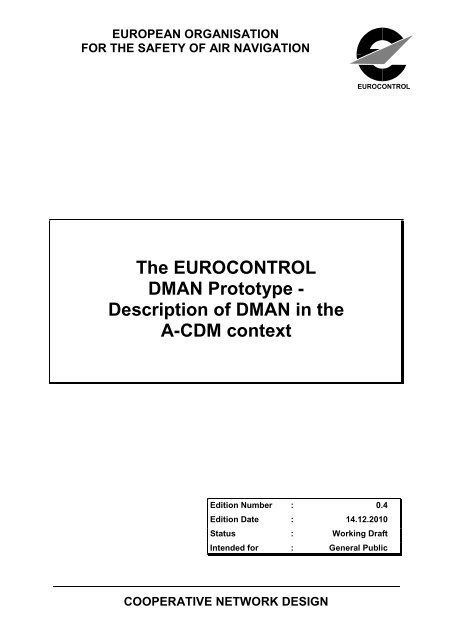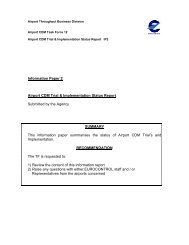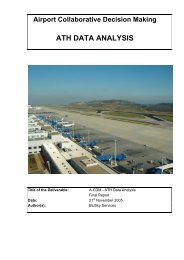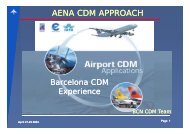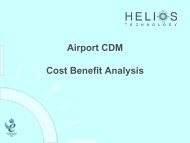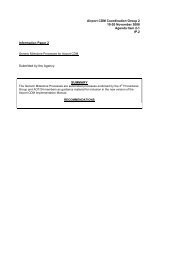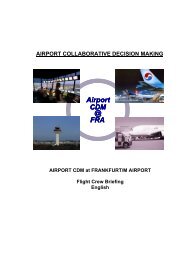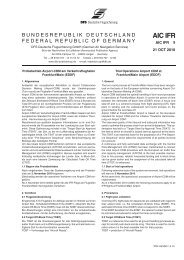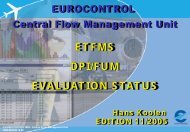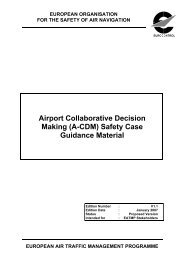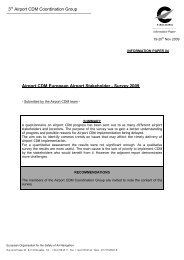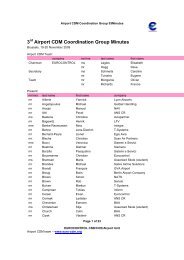Description of DMAN in the A-CDM context - Airport Collaborative ...
Description of DMAN in the A-CDM context - Airport Collaborative ...
Description of DMAN in the A-CDM context - Airport Collaborative ...
Create successful ePaper yourself
Turn your PDF publications into a flip-book with our unique Google optimized e-Paper software.
EUROPEAN ORGANISATION<br />
FOR THE SAFETY OF AIR NAVIGATION<br />
The EUROCONTROL<br />
<strong>DMAN</strong> Prototype -<br />
<strong>Description</strong> <strong>of</strong> <strong>DMAN</strong> <strong>in</strong> <strong>the</strong><br />
A-<strong>CDM</strong> <strong>context</strong><br />
COOPERATIVE NETWORK DESIGN<br />
EUROCONTROL<br />
Edition Number : 0.4<br />
Edition Date : 14.12.2010<br />
Status : Work<strong>in</strong>g Draft<br />
Intended for : General Public
The EUROCONTROL <strong>DMAN</strong> Prototype - <strong>Description</strong> <strong>of</strong> <strong>DMAN</strong> <strong>in</strong> <strong>the</strong> A-<strong>CDM</strong> <strong>context</strong><br />
DOCUMENT CHARACTERISTICS<br />
TITLE<br />
The EUROCONTROL <strong>DMAN</strong> Prototype - <strong>Description</strong> <strong>of</strong><br />
<strong>DMAN</strong> <strong>in</strong> <strong>the</strong> A-<strong>CDM</strong> <strong>context</strong><br />
Publications Reference:<br />
ISBN Number:<br />
Document Identifier Edition Number: 0.4<br />
Edition Date: 14.12.2010<br />
Abstract<br />
The ma<strong>in</strong> purpose <strong>of</strong> a Departure Manager (<strong>DMAN</strong>) is to help aerodrome control to build an<br />
optimized Departure sequence issue <strong>in</strong> accordance with departure demand and departure<br />
capacity. With<strong>in</strong> <strong>the</strong> <strong>CDM</strong>-<strong>context</strong> <strong>the</strong> focus is on <strong>the</strong> TSATs (Target Start-up Approval<br />
Times), which are derived out <strong>of</strong> <strong>the</strong> departure sequence. It is assumed that an electronic<br />
flight strip (EFS) system is <strong>in</strong> place. It maybe exceptionally possible to use <strong>DMAN</strong> with<br />
conventional paper-strips, but <strong>in</strong> any case <strong>the</strong> <strong>DMAN</strong> functionality does not <strong>in</strong>clude <strong>the</strong><br />
display, progress, co-ord<strong>in</strong>ation and transfer <strong>of</strong> departures from one control position to <strong>the</strong><br />
next.<br />
The follow<strong>in</strong>g description is <strong>in</strong>sufficient to build a <strong>DMAN</strong> plann<strong>in</strong>g algorithm without fur<strong>the</strong>r<br />
consideration. The target audience are people <strong>in</strong>volved <strong>in</strong> <strong>the</strong> draft<strong>in</strong>g <strong>of</strong> <strong>DMAN</strong><br />
specifications or <strong>in</strong> <strong>the</strong> procurement and implementation <strong>of</strong> a <strong>DMAN</strong>.<br />
Keywords<br />
Authors<br />
Contact(s) Person Tel Unit<br />
Volker Huck +32 2 7293151 CND/COE/AT/AO<br />
Elisabeth Lagios +32 2 7293390 CND/COE//AT<br />
STATUS, AUDIENCE AND ACCESSIBILITY<br />
Status Intended for Accessible via<br />
Work<strong>in</strong>g Draft General Public Intranet <br />
Draft CND Stakeholders Extranet <br />
Edition: Work<strong>in</strong>g Draft Page 1
The EUROCONTROL <strong>DMAN</strong> Prototype - <strong>Description</strong> <strong>of</strong> <strong>DMAN</strong> <strong>in</strong> <strong>the</strong> A-<strong>CDM</strong> <strong>context</strong><br />
Proposed Issue Restricted Audience Internet (www.eurocontrol.<strong>in</strong>t) <br />
Released Issue Electronic copies <strong>of</strong> this document can be downloaded from : UrlForDoc<br />
Page 2 Work<strong>in</strong>g Draft Edition:
The EUROCONTROL <strong>DMAN</strong> Prototype - <strong>Description</strong> <strong>of</strong> <strong>DMAN</strong> <strong>in</strong> <strong>the</strong> A-<strong>CDM</strong> <strong>context</strong><br />
DOCUMENT APPROVAL<br />
The follow<strong>in</strong>g table identifies all management authorities who have successively approved<br />
<strong>the</strong> present issue <strong>of</strong> this document.<br />
AUTHORITY NAME AND SIGNATURE DATE<br />
Edition: Work<strong>in</strong>g Draft Page 3
The EUROCONTROL <strong>DMAN</strong> Prototype - <strong>Description</strong> <strong>of</strong> <strong>DMAN</strong> <strong>in</strong> <strong>the</strong> A-<strong>CDM</strong> <strong>context</strong><br />
DOCUMENT CHANGE RECORD<br />
The follow<strong>in</strong>g table records <strong>the</strong> complete history <strong>of</strong> <strong>the</strong> successive editions <strong>of</strong> <strong>the</strong> present<br />
document.<br />
EDITION<br />
NUMBER<br />
EDITION<br />
DATE<br />
REASON FOR CHANGE<br />
PAGES<br />
AFFECTED<br />
0.1 5.10.2010 review O. Mongenie, E. Lagios all<br />
0.2 22.10.2010 review R. Lane all<br />
0.3 03.11.2010 review M. Schaper (DLR) all<br />
0.4 14.12.2010 review H. Koolen p.28<br />
Publications<br />
EUROCONTROL Headquarters<br />
96 Rue de la Fusée<br />
B-1130 BRUSSELS<br />
Tel: +32 (0)2 729 1152<br />
Fax: +32 (0)2 729 5149<br />
E-mail: publications@eurocontrol.<strong>in</strong>t<br />
Page 4 Work<strong>in</strong>g Draft Edition:
The EUROCONTROL <strong>DMAN</strong> Prototype - <strong>Description</strong> <strong>of</strong> <strong>DMAN</strong> <strong>in</strong> <strong>the</strong> A-<strong>CDM</strong> <strong>context</strong><br />
Contents<br />
DOCUMENT CHARACTERISTICS.............................................................................1<br />
DOCUMENT APPROVAL ...........................................................................................3<br />
DOCUMENT CHANGE RECORD...............................................................................4<br />
EXECUTIVE SUMMARY.............................................................................................7<br />
CHAPTER 1 – Foreword to <strong>DMAN</strong>............................................................................8<br />
CHAPTER 2 – <strong>DMAN</strong> functions l<strong>in</strong>ked to A-<strong>CDM</strong>....................................................9<br />
CHAPTER 3 – <strong>DMAN</strong> functions ..............................................................................10<br />
3.1 Overview <strong>of</strong> <strong>DMAN</strong> functions...................................................................................10<br />
3.2 Variable Taxi Time Calculator .................................................................................11<br />
3.3 Creation <strong>of</strong> <strong>the</strong> “<strong>in</strong>itial departure sequence” ............................................................12<br />
3.3.1 CFMU-regulated flights ..............................................................................12<br />
3.3.2 Non-regulated flights...................................................................................12<br />
3.3.3 Compact<strong>in</strong>g <strong>the</strong> sequence (clos<strong>in</strong>g <strong>the</strong> un-necessary gaps)......................13<br />
3.4 Departure-departure separation calculator..............................................................13<br />
3.4.1 Wake-vortex separation..............................................................................14<br />
3.4.2 SID-separation ............................................................................................14<br />
3.4.3 Speed-separation........................................................................................15<br />
3.4.4 VFR-departures ..........................................................................................15<br />
3.4.5 Intersection take-<strong>of</strong>fs...................................................................................15<br />
3.5 Runway Sequence Optimizer ..................................................................................15<br />
3.5.1 Slid<strong>in</strong>g w<strong>in</strong>dow method ...............................................................................16<br />
CHAPTER 4 – <strong>DMAN</strong> <strong>in</strong>terface to an EFS system.................................................18<br />
4.1 Clearance Delivery CD ............................................................................................18<br />
4.2 Ground.....................................................................................................................20<br />
4.3 RWY.........................................................................................................................20<br />
4.4 Timel<strong>in</strong>e representation ...........................................................................................22<br />
4.5 Insertion <strong>of</strong> a departure <strong>in</strong>to <strong>the</strong> <strong>DMAN</strong> plan ...........................................................22<br />
4.6 Change <strong>of</strong> flight data after <strong>in</strong>clusion <strong>in</strong> <strong>the</strong> <strong>DMAN</strong> plan...........................................22<br />
4.7 Target Start-up Approval Time (TSAT)....................................................................23<br />
4.8 Late departures........................................................................................................23<br />
4.9 Take <strong>of</strong>f clearance / take <strong>of</strong>f detection.....................................................................23<br />
4.10 Manual Interventions ...............................................................................................23<br />
4.10.1 Sequence Change ......................................................................................23<br />
4.10.2 Sequence Freeze........................................................................................25<br />
4.10.3 Automatic Freeze........................................................................................26<br />
4.10.4 Runway blockage........................................................................................26<br />
Edition: Work<strong>in</strong>g Draft Page 5
The EUROCONTROL <strong>DMAN</strong> Prototype - <strong>Description</strong> <strong>of</strong> <strong>DMAN</strong> <strong>in</strong> <strong>the</strong> A-<strong>CDM</strong> <strong>context</strong><br />
4.10.5 Runway flow adjustment.............................................................................27<br />
CHAPTER 5 – <strong>DMAN</strong> adjustments for particularities ...........................................28<br />
5.1 Creation <strong>of</strong> <strong>the</strong> Target DPI message .......................................................................28<br />
5.1.1 Background.................................................. Error! Bookmark not def<strong>in</strong>ed.<br />
5.2 Cross<strong>in</strong>g runways and o<strong>the</strong>r dependencies between runways ...............................29<br />
5.3 Arrivals on <strong>the</strong> departure runway.............................................................................29<br />
5.4 Runway cross<strong>in</strong>gs....................................................................................................30<br />
5.5 Us<strong>in</strong>g fur<strong>the</strong>r clearances to ref<strong>in</strong>e <strong>the</strong> plann<strong>in</strong>g.......................................................30<br />
5.6 Us<strong>in</strong>g position <strong>in</strong>formation from surface surveillance systems................................31<br />
REFERENCES ..........................................................................................................32<br />
GLOSSARY ....................................................................Error! Bookmark not def<strong>in</strong>ed.<br />
ABBREVIATIONS.....................................................................................................33<br />
Page 6 Work<strong>in</strong>g Draft Edition:
The EUROCONTROL <strong>DMAN</strong> Prototype - <strong>Description</strong> <strong>of</strong> <strong>DMAN</strong> <strong>in</strong> <strong>the</strong> A-<strong>CDM</strong> <strong>context</strong><br />
EXECUTIVE SUMMARY<br />
The EUROCONTROL Departure Manager (<strong>DMAN</strong>) prototype was developed <strong>in</strong> early 2000 <strong>in</strong><br />
collaboration with DLR, <strong>the</strong> German Aerospace Centre. A number <strong>of</strong> simulations were<br />
performed until it was decided that <strong>the</strong> <strong>DMAN</strong> falls <strong>in</strong> <strong>the</strong> area <strong>of</strong> <strong>the</strong> <strong>Airport</strong> <strong>CDM</strong> (A-<strong>CDM</strong>)<br />
project <strong>in</strong> support <strong>of</strong> <strong>the</strong> Pre-departure sequenc<strong>in</strong>g concept element <strong>of</strong> A-<strong>CDM</strong>. With<strong>in</strong> this<br />
scope a number <strong>of</strong> shadow mode trials (Brussels airport) and live shadow mode trial (A<strong>the</strong>ns<br />
airport) have been performed, <strong>in</strong> close collaboration with Belgocontrol, HCAA, and DLR<br />
respectively. 1<br />
The ma<strong>in</strong> purpose <strong>of</strong> a Departure Manager (<strong>DMAN</strong>) is to help aerodrome control to build an<br />
optimized Departure sequence issue <strong>in</strong> accordance with departure demand and departure<br />
capacity. With<strong>in</strong> <strong>the</strong> <strong>CDM</strong>-<strong>context</strong> <strong>the</strong> focus is on <strong>the</strong> TSATs (Target Start-up Approval<br />
Times), which are derived out <strong>of</strong> <strong>the</strong> departure sequence It is assumed that an electronic<br />
flight strip (EFS) system is <strong>in</strong> place. It maybe exceptionally possible to use <strong>DMAN</strong> with<br />
conventional paper-strips, but <strong>in</strong> any case <strong>the</strong> <strong>DMAN</strong> functionality does not <strong>in</strong>clude <strong>the</strong><br />
display, progress, co-ord<strong>in</strong>ation and transfer <strong>of</strong> departures from one control position to <strong>the</strong><br />
next.<br />
This document [<strong>in</strong>formation paper] does not specify a <strong>DMAN</strong> system to <strong>the</strong> detailed level <strong>of</strong><br />
Operational or Technical Requirements. Ra<strong>the</strong>r it should be seen as provid<strong>in</strong>g background,<br />
and additional <strong>in</strong>formation, to those responsible for specify<strong>in</strong>g <strong>the</strong>ir own <strong>DMAN</strong> requirements,<br />
or to those responsible for a <strong>DMAN</strong> procurement and implementation process.<br />
The description is not <strong>in</strong>tended as a generic def<strong>in</strong>ition or as best practice, as no stakeholder<br />
consultation process has been followed at this stage.<br />
1 The field-trials <strong>in</strong> A<strong>the</strong>ns have been performed by DLR’s “Controller Assistance for Departure Optimization” CADEO, a followon<br />
development <strong>of</strong> <strong>the</strong> EUROCONTROL / DLR <strong>DMAN</strong> prototype<br />
Edition: Work<strong>in</strong>g Draft Page 7
The EUROCONTROL <strong>DMAN</strong> Prototype - <strong>Description</strong> <strong>of</strong> <strong>DMAN</strong> <strong>in</strong> <strong>the</strong> A-<strong>CDM</strong> <strong>context</strong><br />
CHAPTER 1 – Foreword to <strong>DMAN</strong><br />
EUROCONTROL def<strong>in</strong>es <strong>DMAN</strong> as a plann<strong>in</strong>g system to improve departure flows at<br />
one or more airports by calculat<strong>in</strong>g <strong>the</strong> Target Take Off Time (TTOT) and Target Start<br />
Up Approval Time (TSAT) for each flight, tak<strong>in</strong>g multiple constra<strong>in</strong>ts and preferences<br />
<strong>in</strong>to account.<br />
<strong>DMAN</strong> systems have a wide range <strong>of</strong> sophistication-levels.<br />
Departure management <strong>in</strong> <strong>the</strong> A-<strong>CDM</strong> <strong>context</strong> can take place more than 60 m<strong>in</strong>utes before<br />
<strong>of</strong>f block time. However, <strong>in</strong> reality a stable sequence is most likely to be achieved much later.<br />
The ma<strong>in</strong> purpose (but not <strong>the</strong> only one) is to have TSATs result<strong>in</strong>g <strong>in</strong> a desirable departure<br />
queue at <strong>the</strong> runway and Target Take Off Times (TTOT) that can be used by o<strong>the</strong>r parts <strong>of</strong><br />
<strong>the</strong> air traffic network (CFMU, dest<strong>in</strong>ation airport, receiv<strong>in</strong>g ATC-units etc)..<br />
In <strong>the</strong> follow<strong>in</strong>g description <strong>of</strong> <strong>the</strong> EUROCONTROL/DLR prototype, <strong>DMAN</strong> supports runway<br />
sequence optimisation and is dynamic. At a certa<strong>in</strong> po<strong>in</strong>t <strong>in</strong> time <strong>the</strong> TSAT agreement<br />
between aerodrome ATC and airport/airl<strong>in</strong>e rema<strong>in</strong>s stable, but <strong>the</strong> <strong>DMAN</strong> system will adjust<br />
<strong>the</strong> plan <strong>in</strong> <strong>the</strong> background, tak<strong>in</strong>g account <strong>of</strong> actual events.<br />
Those adjustments are displayed to relevant controller work<strong>in</strong>g positions to support <strong>the</strong><br />
tactical handl<strong>in</strong>g <strong>of</strong> departures and may result <strong>in</strong> exceptional TSAT changes.<br />
It is assumed, that <strong>the</strong> <strong>DMAN</strong> is not yet <strong>in</strong>tegrated with a surface surveillance system, so that<br />
<strong>the</strong> progress <strong>of</strong> <strong>the</strong> flight is taken from controller <strong>in</strong>puts on EFS.<br />
Fur<strong>the</strong>r developments are expected to take place <strong>in</strong> SESAR (S<strong>in</strong>gle European Sky ATM<br />
Research):<br />
WP6: P6.8.4 Coupled AMAN-<strong>DMAN</strong><br />
WP5: P5.6.7 Integrated Sequence Build<strong>in</strong>g/Optimisation <strong>of</strong> Queues<br />
Page 8 Work<strong>in</strong>g Draft Edition:
The EUROCONTROL <strong>DMAN</strong> Prototype - <strong>Description</strong> <strong>of</strong> <strong>DMAN</strong> <strong>in</strong> <strong>the</strong> A-<strong>CDM</strong> <strong>context</strong><br />
CHAPTER 2 – <strong>DMAN</strong> functions<br />
l<strong>in</strong>ked to A-<strong>CDM</strong><br />
The follow<strong>in</strong>g is an excerpt from <strong>the</strong> A-<strong>CDM</strong> Implementation Manual:<br />
In most situations <strong>in</strong> air traffic management, <strong>the</strong> pr<strong>in</strong>ciple <strong>of</strong> “first come first served” is applied, and<br />
predeparture sequenc<strong>in</strong>g is no different. The result is that flights are <strong>of</strong>ten pushed back <strong>in</strong> an<br />
order that is not <strong>the</strong> best <strong>in</strong> <strong>the</strong> given ATC situation and/or which does not take <strong>in</strong>to account <strong>the</strong><br />
preferences <strong>of</strong> <strong>the</strong> aircraft operators. <strong>Collaborative</strong> predeparture sequenc<strong>in</strong>g allows<br />
ATC to arrange <strong>the</strong> Target Off Block Times (TOBT) obta<strong>in</strong>ed from <strong>the</strong> Turn-Round Process <strong>in</strong> a way<br />
that flights can depart from <strong>the</strong>ir stands <strong>in</strong> <strong>the</strong> optimum order.<br />
The ma<strong>in</strong> objectives <strong>of</strong> <strong>Collaborative</strong> Predeparture Sequence are:<br />
■Enhance flexibility<br />
■Improve punctuality<br />
■Improve slot adherence<br />
■Improve transparency<br />
■Improve ground handl<strong>in</strong>g efficiency<br />
■Improve stand and gate management<br />
Where collaborative predeparture sequenc<strong>in</strong>g is used, Aircraft Operators/Ground Handlers are<br />
able to communicate preferences to ATC who will take <strong>the</strong>se <strong>in</strong>to account toge<strong>the</strong>r with o<strong>the</strong>r<br />
operational constra<strong>in</strong>ts such as Calculated Take Off Times (CTOTs), o<strong>the</strong>r traffic and <strong>the</strong> required<br />
take <strong>of</strong>f sequence. The partners will be able to work toge<strong>the</strong>r and with ATC to optimise <strong>the</strong> start up<br />
order even <strong>in</strong> very complicated circumstances, improv<strong>in</strong>g punctuality.<br />
The optimised predeparture sequence will lead to more accurate Target Take Off Times (TTOTs).<br />
Any TTOT which falls outside <strong>the</strong> slot tolerance w<strong>in</strong>dow will raise an alarm and so timely action<br />
can be taken to resolve <strong>the</strong> discrepancy. All partners will benefit from <strong>the</strong> improved transparency<br />
<strong>of</strong> <strong>the</strong> operational situation. For example, ground handlers will be able to position <strong>the</strong>ir<br />
resources e.g. push back tugs, more efficiently as <strong>the</strong>y will know exactly <strong>in</strong> which order and when<br />
<strong>the</strong> flights will depart. Stand and gate management will be able to plan<br />
stands with more precision and AOs will be able to manage <strong>the</strong>ir flights accord<strong>in</strong>g to <strong>the</strong>ir preferences<br />
and have a better overview <strong>of</strong> <strong>the</strong>ir aircraft movements<br />
Optimisation <strong>of</strong> <strong>the</strong> take-<strong>of</strong>f sequence is not strictly followed <strong>in</strong> pre-departure sequenc<strong>in</strong>g, but<br />
can be taken <strong>in</strong>to account. In this case, <strong>the</strong> TTOTs are not a mere result <strong>of</strong> pre-departure<br />
sequenc<strong>in</strong>g until TOBT, but take account <strong>of</strong> <strong>in</strong>dividual departure-departure separation <strong>in</strong><br />
accordance with local rules. More advanced concepts <strong>in</strong>clude AMAN/<strong>DMAN</strong> coupl<strong>in</strong>g. On<br />
mixed mode runways <strong>the</strong>y require also reference to arrival-departure, departure-arrival and<br />
arrival-arrival separation. In order to rema<strong>in</strong> concise, <strong>the</strong>ir discussion is omitted <strong>in</strong> this<br />
document.<br />
Edition: Work<strong>in</strong>g Draft Page 9
The EUROCONTROL <strong>DMAN</strong> Prototype - <strong>Description</strong> <strong>of</strong> <strong>DMAN</strong> <strong>in</strong> <strong>the</strong> A-<strong>CDM</strong> <strong>context</strong><br />
CHAPTER 3 –<strong>DMAN</strong> functions<br />
3.1 Overview <strong>of</strong> <strong>DMAN</strong> functions<br />
This overview expla<strong>in</strong>s how all <strong>the</strong> <strong>DMAN</strong> functions work toge<strong>the</strong>r. It also summarizes those<br />
sub-functions “<strong>in</strong> a nutshell”. Readers that are fully familiar with architecture and design <strong>of</strong><br />
<strong>DMAN</strong> functionality may skip this overview..<br />
<strong>DMAN</strong> takes each departure <strong>in</strong> its plann<strong>in</strong>g horizon with TOBT/EOBT with<strong>in</strong> <strong>the</strong> next 90<br />
m<strong>in</strong>utes, which was discovered to be a reasonable parameter value. The value is adaptable<br />
to different needs. The TOBT is <strong>the</strong> time that <strong>the</strong> aircraft operator or <strong>the</strong> handl<strong>in</strong>g agent<br />
claims <strong>the</strong> aircraft will be ready for start/push. One prom<strong>in</strong>ent functionality <strong>of</strong> <strong>DMAN</strong> is <strong>the</strong><br />
calculation <strong>of</strong> <strong>the</strong> expected Taxi Out Time (EXOT) for each departure. It can be broken down<br />
<strong>in</strong>to <strong>the</strong> start/push phase (from pushback clearance to <strong>the</strong> “ready to taxi” status), <strong>the</strong> taxiphase<br />
(from taxi clearance to <strong>the</strong> last position <strong>of</strong> <strong>the</strong> departure queue), <strong>the</strong> queu<strong>in</strong>g phase<br />
and <strong>the</strong> l<strong>in</strong>e-up phase.<br />
The EOBT/TOBT plus <strong>the</strong> EXOT is <strong>the</strong> time that <strong>DMAN</strong> assumes <strong>the</strong> flight to be ready for<br />
take <strong>of</strong>f, <strong>the</strong> Estimated Take <strong>of</strong>f Times (ETOTs)/Target Take <strong>of</strong>f Times (TTOTs). The<br />
E/TTOTs and CTOTs (orig<strong>in</strong>at<strong>in</strong>g from CFMU) are <strong>the</strong> basis for creat<strong>in</strong>g an “<strong>in</strong>itial departure<br />
sequence” as <strong>the</strong> next step <strong>in</strong> <strong>the</strong> <strong>DMAN</strong> process. Firstly, all flights with a CFMU restriction<br />
(and only those) are placed on <strong>the</strong> departure timel<strong>in</strong>e with <strong>the</strong>ir exact CTOT. Then <strong>the</strong><br />
unregulated departures are sequenced around <strong>the</strong> regulated flights, tak<strong>in</strong>g <strong>in</strong>to account <strong>the</strong><br />
required separation to <strong>the</strong> preced<strong>in</strong>g departure. The separation-calculator is ano<strong>the</strong>r keyfunction<br />
<strong>of</strong> <strong>DMAN</strong>. Now <strong>the</strong> “<strong>in</strong>itial departure sequence” is established.<br />
The next step <strong>in</strong> <strong>the</strong> <strong>DMAN</strong> process is <strong>the</strong> optimization <strong>of</strong> <strong>the</strong> <strong>in</strong>itial departure sequence. The<br />
usefulness <strong>of</strong> this function has been established <strong>in</strong> simulations, but not <strong>in</strong> live-trials. It is<br />
<strong>the</strong>refore important that <strong>the</strong> function can be de-activated and <strong>the</strong> “<strong>in</strong>itial departure sequence”<br />
is used. An example for optimization: Assume <strong>the</strong>re is a separation <strong>of</strong> 120sec between flights<br />
that turn <strong>in</strong>to <strong>the</strong> same direction (both to <strong>the</strong> left L-L or both to <strong>the</strong> right R-R) and only 60sec<br />
separation between L-R and R-L. Assume fur<strong>the</strong>r <strong>the</strong> “<strong>in</strong>itial departure sequence” renders L-<br />
L-L-R-R-R, requir<strong>in</strong>g 9m<strong>in</strong> from <strong>the</strong> first to <strong>the</strong> last take-<strong>of</strong>f clearance <strong>in</strong> <strong>the</strong>ory. If you can reschedule<br />
those departures L-R-L-R-L-R <strong>the</strong>n <strong>in</strong> <strong>the</strong>ory, <strong>the</strong>y only need 5m<strong>in</strong>. Now, if<br />
applicable, <strong>the</strong> “optimized departure sequence” is established. Each flight has a TTOT.<br />
The next step <strong>in</strong> <strong>the</strong> process is to calculate backwards to <strong>the</strong> TSAT. It consists simply <strong>of</strong><br />
subtract<strong>in</strong>g <strong>the</strong> value for <strong>the</strong> EXOT multiplied by an extension factor from <strong>the</strong> TTOT. The<br />
extension factor is parameterized and used to cope with uncerta<strong>in</strong>ty <strong>of</strong> <strong>the</strong> times <strong>in</strong> <strong>the</strong><br />
ground progress. Ideally (extension factor =1), <strong>the</strong> so-calculated TSAT should ensure that<br />
each flight arrives at <strong>the</strong> runway exactly at <strong>the</strong> time it is needed for immediate take <strong>of</strong>f,<br />
however, it is accepted as a good practice for runway optimization to always have a buffer <strong>of</strong><br />
3-5 aircraft at <strong>the</strong> runway <strong>in</strong> departure peaks, <strong>in</strong> order to cater for <strong>the</strong> obvious randomness <strong>in</strong><br />
<strong>the</strong> ground progress. This can be taken <strong>in</strong>to account by enlarg<strong>in</strong>g <strong>the</strong> extension factor or<br />
simply left to <strong>the</strong> respective aerodrome control position.<br />
When an ATOT is received, <strong>the</strong> departure is deleted from <strong>the</strong> sequence. In <strong>the</strong>ory, that<br />
should always be <strong>the</strong> first flight <strong>of</strong> <strong>the</strong> present sequence at <strong>the</strong> TTOT. Then <strong>the</strong> rema<strong>in</strong>der <strong>of</strong><br />
<strong>the</strong> sequence and <strong>the</strong> entire schedule rema<strong>in</strong>s unchanged. If A-SMGCS surveillance /EFS<br />
data are not available for <strong>DMAN</strong>, it may happen, that <strong>the</strong> <strong>DMAN</strong> sequence does not always<br />
Page 10 Work<strong>in</strong>g Draft Edition:
The EUROCONTROL <strong>DMAN</strong> Prototype - <strong>Description</strong> <strong>of</strong> <strong>DMAN</strong> <strong>in</strong> <strong>the</strong> A-<strong>CDM</strong> <strong>context</strong><br />
reflect <strong>the</strong> real sequence at <strong>the</strong> runway hold<strong>in</strong>g po<strong>in</strong>t. In this case <strong>the</strong> respective flight must<br />
be deleted <strong>in</strong>dependently <strong>of</strong> <strong>the</strong> planned number <strong>in</strong> sequence and <strong>the</strong> rema<strong>in</strong><strong>in</strong>g flights will<br />
be adjusted.<br />
If a manual is issued to an aircraft by a controller this has to be made known <strong>in</strong> <strong>the</strong> <strong>DMAN</strong><br />
system. If it differs from <strong>the</strong> <strong>DMAN</strong>-plan it will over-write <strong>the</strong> <strong>DMAN</strong> TSAT. After <strong>the</strong> TSAT is<br />
issued <strong>the</strong> <strong>DMAN</strong> system will try to keep <strong>the</strong> TTOT for this flight stable <strong>in</strong> <strong>the</strong> plan.<br />
Departures that are not yet coord<strong>in</strong>ated via <strong>the</strong> TSAT will be re-planned, if necessary, <strong>in</strong><br />
accordance with <strong>the</strong>ir TOBT.<br />
The follow<strong>in</strong>g sections repeat <strong>the</strong> <strong>in</strong>troduction and go more <strong>in</strong>to detail. All steps to calculate<br />
<strong>the</strong> optimized sequence are repeated to adapt to changes. Examples for changes are:<br />
• New departures enter <strong>the</strong> <strong>DMAN</strong> plann<strong>in</strong>g horizon<br />
• Changes to TOBT, CTOT<br />
• Given Clearances or ASAT, ATOT<br />
• Changed ELDT/TLDT for arrivals, if mixed mode is used or <strong>the</strong> arrival runway is<br />
dependent.<br />
• Changes to RWY or SID<br />
3.2 Variable Taxi Time Calculator<br />
The Variable Taxi Time calculator shall return <strong>the</strong> unimpeded taxi out time from Start/push to<br />
<strong>the</strong> arrival <strong>of</strong> <strong>the</strong> aircraft at <strong>the</strong> departure runway. In accordance with <strong>the</strong> A-<strong>CDM</strong> def<strong>in</strong>ition for<br />
<strong>the</strong> Estimated Taxi Out Time EXOT, <strong>the</strong> departure can be assumed to be ready for departure<br />
at that time. The EXOT will need to also take <strong>in</strong>to account any queu<strong>in</strong>g time.<br />
<strong>DMAN</strong> holds models for <strong>the</strong> departure processes needed for each flight. The system will<br />
know <strong>the</strong> assigned park<strong>in</strong>g positions, and if <strong>the</strong> departure needs a pushback or not. The<br />
model holds also <strong>the</strong> times <strong>the</strong> operational steps take, start<strong>in</strong>g with a clearance.<br />
For <strong>the</strong> taxi time itself <strong>the</strong> process starts with ei<strong>the</strong>r a simple look-up table or from ASMGCS<br />
Rout<strong>in</strong>g function, if available. The rows and columns <strong>of</strong> <strong>the</strong> table hold <strong>the</strong> location <strong>of</strong> <strong>the</strong><br />
aircraft and <strong>the</strong> dest<strong>in</strong>ation runway, respectively. Opposite ends <strong>of</strong> a runway (e.g. RWY29<br />
and RWY11) are considered as two different runways.<br />
The location <strong>of</strong> a depart<strong>in</strong>g aircraft is its park<strong>in</strong>g position (stand). It is acceptable to group<br />
park<strong>in</strong>g positions, dependant on <strong>the</strong> complexity <strong>of</strong> <strong>the</strong> airfield and <strong>the</strong> requirement for<br />
granularity. At many airports a “natural” group<strong>in</strong>g exists via <strong>the</strong> division <strong>of</strong> park<strong>in</strong>g positions<br />
<strong>in</strong>to gate-areas or aprons.<br />
Taxi times and taxi speeds can vary greatly, even if <strong>the</strong> pre-conditions are similar, hence<br />
<strong>the</strong>y are difficult to predict. For a stand/runway comb<strong>in</strong>ation with an average taxi time <strong>of</strong> 5<br />
m<strong>in</strong>utes, <strong>the</strong>re will still be about 20% <strong>of</strong> <strong>the</strong> departures that need less than 3 m<strong>in</strong>utes or more<br />
than 7 m<strong>in</strong>utes. It is recommended to ref<strong>in</strong>e <strong>the</strong> ground progress time calculator only with<br />
criteria that have a clearly measurable effect.<br />
See for example Eurocontrol <strong>in</strong>ternal report ASA.02.AMAN/<strong>DMAN</strong>.Del05.SUM.<br />
EXOT timetables should be kept simple, because <strong>the</strong>y will need updat<strong>in</strong>g for any changes on<br />
<strong>the</strong> airport layout or taxi procedure from time to time.<br />
Edition: Work<strong>in</strong>g Draft Page 11
The EUROCONTROL <strong>DMAN</strong> Prototype - <strong>Description</strong> <strong>of</strong> <strong>DMAN</strong> <strong>in</strong> <strong>the</strong> A-<strong>CDM</strong> <strong>context</strong><br />
3.3 Creation <strong>of</strong> <strong>the</strong> “<strong>in</strong>itial departure sequence”<br />
A departure sequence is well def<strong>in</strong>ed for one departure runway or for a set <strong>of</strong> dependent<br />
departure runways, for example cross<strong>in</strong>g runways. In case <strong>of</strong> two or more <strong>in</strong>dependent<br />
departure runways <strong>the</strong>re is no use to plan a sequence <strong>of</strong> events, if <strong>the</strong> events do not need<br />
synchronization. This means that <strong>in</strong> case <strong>of</strong> two <strong>in</strong>dependent runways two <strong>in</strong>dependent<br />
sequences can be built.<br />
Therefore <strong>the</strong> <strong>in</strong>itial departure sequence is <strong>the</strong> sequence <strong>of</strong> Estimated/Calculated Take <strong>of</strong>f<br />
Times ETOT,/CTOT for each set <strong>of</strong> dependant departure runways.<br />
3.3.1 CFMU-regulated flights<br />
Firstly all regulated flights are placed <strong>in</strong> <strong>the</strong> order <strong>of</strong> <strong>the</strong>ir CTOTs. If one or more departures<br />
have <strong>the</strong> same CTOT, <strong>the</strong>y must be sequenced with ano<strong>the</strong>r criterion, for example <strong>the</strong><br />
SOBT/EOBT should be taken <strong>in</strong>to account (most delayed flight should go first).<br />
Then <strong>the</strong> required departure-departure separation must be put between <strong>the</strong> regulated flights<br />
by shift<strong>in</strong>g <strong>the</strong> succeed<strong>in</strong>g departures <strong>of</strong> detected conflicts backwards some flights may<br />
now be later than <strong>the</strong>ir CTOT, but none earlier.<br />
3.3.2 Non-regulated flights<br />
This is an excerpt from a <strong>DMAN</strong><br />
EXOT/EXIT-table: Column A has <strong>the</strong><br />
specific aprons or areas on <strong>the</strong><br />
airfield, column B <strong>the</strong> specific<br />
runway, column C tells how much<br />
time <strong>in</strong> seconds an arrival is<br />
expected to taxi from <strong>the</strong> (most<br />
likely) exit to a position on that<br />
respective apron (EXIT), Column D<br />
<strong>the</strong> taxi time from a position on that<br />
apron to <strong>the</strong> runway head (EXOT).<br />
Next <strong>the</strong> non-regulated flights share <strong>the</strong> rema<strong>in</strong>der <strong>of</strong> <strong>the</strong> departure time-l<strong>in</strong>e like follows:<br />
start<strong>in</strong>g with <strong>the</strong> earliest E/TTOT, all flights are put <strong>in</strong> sequence with <strong>the</strong> respective<br />
separation, unless <strong>the</strong>y conflict with <strong>the</strong> CTOT-flight. Then <strong>the</strong>y must be placed beh<strong>in</strong>d. For<br />
those flights that have <strong>the</strong> exact same E/TTOT, <strong>the</strong>y also need to be “randomly” sequenced<br />
Page 12 Work<strong>in</strong>g Draft Edition:
The EUROCONTROL <strong>DMAN</strong> Prototype - <strong>Description</strong> <strong>of</strong> <strong>DMAN</strong> <strong>in</strong> <strong>the</strong> A-<strong>CDM</strong> <strong>context</strong><br />
or <strong>in</strong> accordance with a “fairness-rule”, like that described for <strong>the</strong> regulated flights. Identical<br />
E/TTOTs are not uncommon, assum<strong>in</strong>g <strong>the</strong> EXOT timetable entries and <strong>the</strong> TOBTs to be <strong>in</strong><br />
<strong>in</strong>tegral m<strong>in</strong>utes.<br />
3.3.3 Compact<strong>in</strong>g <strong>the</strong> sequence (clos<strong>in</strong>g <strong>the</strong> un-necessary gaps)<br />
The runway schedule will now have unnecessary gaps. Imag<strong>in</strong>e <strong>the</strong> follow<strong>in</strong>g: Flight#1 is<br />
non-regulated and violates separation-criteria to its regulated follower flight#2 by say 10<br />
seconds. Then it needs to be scheduled beh<strong>in</strong>d flight#2 or even delayed fur<strong>the</strong>r. But this may<br />
create a gap <strong>in</strong> front <strong>of</strong> flight#2. Each time this happens <strong>the</strong> regulated flights (flight#2 <strong>in</strong> <strong>the</strong><br />
example) shall be advanced by <strong>the</strong> least <strong>of</strong> <strong>the</strong> follow<strong>in</strong>g:<br />
• Without violat<strong>in</strong>g separation m<strong>in</strong>ima to <strong>the</strong> new predecessor<br />
• As much as needed to allow <strong>the</strong> succeed<strong>in</strong>g non-regulated flight (flight#1 <strong>in</strong> our<br />
example) to take <strong>of</strong>f at E/TTOT<br />
• to rema<strong>in</strong> <strong>in</strong>side <strong>the</strong> CFMU slot (CTOT m<strong>in</strong>us 5 m<strong>in</strong> through CTOT plus 10 m<strong>in</strong>)<br />
Note 1: A prom<strong>in</strong>ent feature <strong>of</strong> <strong>the</strong> A-<strong>CDM</strong> concept is <strong>the</strong> improved co-operation between<br />
airport and CFMU and <strong>the</strong> l<strong>in</strong>k<strong>in</strong>g <strong>of</strong> airport to <strong>the</strong> ATM network via updated departure<br />
<strong>in</strong>formation. In this <strong>context</strong> <strong>the</strong>re is a def<strong>in</strong>ed DPI-message (Departure Plann<strong>in</strong>g Information)<br />
for each departure. For this message <strong>the</strong> <strong>DMAN</strong> needs to provide a virtual “what-if” plann<strong>in</strong>g<br />
for regulated flights, as if <strong>the</strong> flight had no slot. It is used <strong>in</strong> <strong>the</strong> CFMU for <strong>the</strong> provision <strong>of</strong><br />
“slot-improvements”.<br />
This could be an <strong>in</strong>itial departure<br />
sequence. It is actually<br />
compacted. Note <strong>the</strong> 2 m<strong>in</strong>ute<br />
separation between DAT19M,<br />
BMA234 and COA61. They are<br />
due to <strong>the</strong> fact <strong>the</strong> departures<br />
depart on <strong>the</strong> same SID. The<br />
sequence results from <strong>the</strong><br />
applicable TTOTs and <strong>the</strong><br />
separation values.<br />
Note 2: The <strong>DMAN</strong> prototype does not create an “<strong>in</strong>itial departure sequence” based on first –<br />
come- first-served pr<strong>in</strong>ciple by default. It creates <strong>the</strong> respective optimised sequence order. If<br />
<strong>the</strong> Controller wants to see <strong>the</strong> “<strong>in</strong>itial departure sequence” based on that pr<strong>in</strong>ciple, he has to<br />
change <strong>the</strong> plann<strong>in</strong>g strategy to first-come-first-serve(“FCFS”). The <strong>DMAN</strong> prototype<br />
supports a pre-def<strong>in</strong>ed set <strong>of</strong> different plann<strong>in</strong>g strategies and allow to specify additional<br />
ones. When <strong>the</strong> plann<strong>in</strong>g strategy is changed to FCFS <strong>the</strong>n <strong>in</strong>stead <strong>of</strong> <strong>the</strong> optimised<br />
sequence <strong>the</strong> first-come-first-serve sequence is shown.<br />
3.4 Departure-departure separation calculator<br />
Departure-departure separation rules may vary from country to country and also airport to<br />
airport. They typically fall <strong>in</strong>to three categories:<br />
Edition: Work<strong>in</strong>g Draft Page 13
1) Wake-vortex separation (WV)<br />
The EUROCONTROL <strong>DMAN</strong> Prototype - <strong>Description</strong> <strong>of</strong> <strong>DMAN</strong> <strong>in</strong> <strong>the</strong> A-<strong>CDM</strong> <strong>context</strong><br />
2) SID separation (Standard Instrument Departure)<br />
3) Speed category separation<br />
To get <strong>the</strong> separation <strong>the</strong> maximum <strong>of</strong> <strong>the</strong> three (WV, SID, speed) per departure-departure<br />
pair is taken.<br />
3.4.1 Wake-vortex separation<br />
The Wake-vortex separation is normally dependant on <strong>the</strong> departure’s ICAO classification as<br />
Heavy, Medium or Light (o<strong>the</strong>r categories exist <strong>in</strong> different countries). The applicable set <strong>of</strong><br />
values for <strong>the</strong> respective airport can be easily edited <strong>in</strong>to a small table.<br />
3.4.2 SID-separation<br />
The SID-separation is dependant on <strong>the</strong> first turn <strong>in</strong> <strong>the</strong> SID, ra<strong>the</strong>r than <strong>the</strong> later direction <strong>of</strong><br />
<strong>the</strong> route. The respective number <strong>of</strong> m<strong>in</strong>utes required between two flights can be kept <strong>in</strong> a<br />
table.<br />
This is part <strong>of</strong> a SIDseparation<br />
table. For<br />
each pair <strong>of</strong> SIDs an<br />
entry <strong>of</strong> (LL, RR, LR,<br />
RL, DSG, or DSGX),<br />
tell<strong>in</strong>g whe<strong>the</strong>r <strong>the</strong><br />
departures turn <strong>the</strong><br />
same direction (LL,<br />
RR), different<br />
directions (LR, RL),<br />
are <strong>in</strong> <strong>in</strong>dependent<br />
different SID groups<br />
(DSG) or dependant<br />
different SID groups<br />
DSG X. DSGs apply<br />
for day-SIDs and<br />
night SIDs and<br />
DSG_Xs apply for<br />
SIDs from different<br />
runways at <strong>the</strong> same<br />
time.<br />
Page 14 Work<strong>in</strong>g Draft Edition:
The EUROCONTROL <strong>DMAN</strong> Prototype - <strong>Description</strong> <strong>of</strong> <strong>DMAN</strong> <strong>in</strong> <strong>the</strong> A-<strong>CDM</strong> <strong>context</strong><br />
3.4.3 Speed-separation<br />
The speed separation may apply only for SIDs that share a common path element. If that is<br />
so, common-path SIDs need to be kept <strong>in</strong> list<strong>in</strong>gs <strong>of</strong> respective sets. The respective<br />
separation-value can be kept <strong>in</strong> a table and only applies for departures with <strong>the</strong> same SID or<br />
<strong>the</strong> same common-path group.<br />
3.4.4 VFR-departures<br />
The m<strong>in</strong>imum separation between IFR-departures is 60 seconds. However, <strong>the</strong>re is <strong>the</strong><br />
possibility to release a departure beh<strong>in</strong>d a VFR departure after it vacates <strong>the</strong> centerl<strong>in</strong>e<br />
extension axis. That may be before 60 seconds have expired. It is, however difficult to<br />
forecast and <strong>the</strong>refore probably not worth <strong>the</strong> effort.<br />
Important: The departure-departure separation calculator can only be used for plann<strong>in</strong>g <strong>the</strong><br />
sequence and <strong>the</strong> result<strong>in</strong>g schedule. It cannot not be used for actual separation assurance<br />
or separation violation warn<strong>in</strong>g!!!<br />
3.4.5 Intersection take-<strong>of</strong>fs<br />
Intersection take-<strong>of</strong>fs may need different spac<strong>in</strong>g. However, <strong>the</strong> fact whe<strong>the</strong>r or not a<br />
departure will request/accept an <strong>in</strong>tersection take <strong>of</strong>f depends on various factors and is<br />
known late <strong>in</strong> <strong>the</strong> process. The application <strong>of</strong> special separation rules for <strong>DMAN</strong> plann<strong>in</strong>g<br />
shall only be implemented if <strong>in</strong>tersection-take<strong>of</strong>fs can be confidently forecast early.<br />
Intermediate hold<strong>in</strong>g po<strong>in</strong>ts and <strong>in</strong>tersection take <strong>of</strong>fs can be fed <strong>in</strong>to <strong>DMAN</strong> via <strong>the</strong> EFS/A-<br />
SMGCS as part <strong>of</strong> <strong>the</strong> rout<strong>in</strong>g function.<br />
3.5 Runway Sequence Optimizer<br />
The respective<br />
separation values<br />
<strong>in</strong> seconds.<br />
Runway sequence optimization has been evaluated <strong>in</strong> various fast-time simulations. It can<br />
render 7% <strong>in</strong>crease <strong>in</strong> runway throughput, dependant on <strong>the</strong> mix <strong>of</strong> traffic <strong>in</strong> terms <strong>of</strong> wakevortex<br />
category, SID and speed.<br />
See Eurocontrol <strong>in</strong>ternal ASA02.<strong>DMAN</strong>.DEL05.FEA for departure runways and<br />
ASA.02.AMAN/<strong>DMAN</strong>.DEL04.REP for mixed mode runways.<br />
Those fast time simulations only compared random take-<strong>of</strong>f sequences with fully optimized<br />
Edition: Work<strong>in</strong>g Draft Page 15
The EUROCONTROL <strong>DMAN</strong> Prototype - <strong>Description</strong> <strong>of</strong> <strong>DMAN</strong> <strong>in</strong> <strong>the</strong> A-<strong>CDM</strong> <strong>context</strong><br />
sequences and <strong>the</strong>refore lack reality. They assume specifically that:<br />
- <strong>the</strong>re is a cont<strong>in</strong>uous over-demand <strong>of</strong> departures<br />
- <strong>the</strong> ground and runway controllers only perform sequence-improvements by swapp<strong>in</strong>g two<br />
consecutive departures.<br />
<strong>DMAN</strong> performs sequence-improvements<br />
- by check<strong>in</strong>g many possible permutations <strong>of</strong> <strong>the</strong> departure sequence<br />
- departures take-<strong>of</strong>f with <strong>the</strong> exact separation-spac<strong>in</strong>g assumed<br />
- <strong>the</strong> optimized runway sequence can be achieved 100%.<br />
Up to now, <strong>the</strong> <strong>in</strong>crease <strong>in</strong> runway throughput has not been proven <strong>in</strong> real time simulations or<br />
field-trials. That means that <strong>the</strong> usefulness <strong>of</strong> runway sequence optimization is not proven. If<br />
applied, it should be always possible to neutralize <strong>the</strong> optimization and plan on <strong>the</strong> “<strong>in</strong>itial<br />
departure sequence”.<br />
3.5.1 Slid<strong>in</strong>g w<strong>in</strong>dow method<br />
There are several possibilities to program <strong>the</strong> optimization, given here is <strong>the</strong> “slid<strong>in</strong>g w<strong>in</strong>dow”<br />
algorithm. It looks at one set <strong>of</strong> departures at a time (first <strong>the</strong> w<strong>in</strong>dow A, B, C, D, E) and <strong>the</strong>n<br />
slides that w<strong>in</strong>dow down <strong>the</strong> entire set <strong>of</strong> departures (A, B, C, D, E, <strong>the</strong>n B, C, D, E, F, <strong>the</strong>n<br />
C, D, E, F, G, <strong>the</strong>n D, E, F, G, H etc). There should be a maximum position-shift, for example<br />
three. That means flight#23 <strong>in</strong> <strong>the</strong> <strong>in</strong>itial departure sequence (IDS) can only have numbers<br />
between #20 and #26 <strong>in</strong> <strong>the</strong> optimized departure sequence (ODS). O<strong>the</strong>rwise certa<strong>in</strong><br />
departures (light and slow aircraft, for example) would be delayed <strong>in</strong>def<strong>in</strong>itely.<br />
Each slid<strong>in</strong>g w<strong>in</strong>dow-run translates <strong>the</strong> entire IDS <strong>in</strong>to an ODS. It starts with <strong>the</strong> first five<br />
departures (numbers A, B, C, D, E) and tries all 120 permutations <strong>of</strong> those five flights. Those<br />
48 permutations that start with an E or end <strong>in</strong> an A are discarded, because <strong>the</strong>y violate <strong>the</strong><br />
maximum position-shift rule. For <strong>the</strong> o<strong>the</strong>r 78 a fictional schedule is built, that means each<br />
flight gets a fictional departure time. There are, <strong>of</strong> course, conditions: No flight will be<br />
planned to take <strong>of</strong>f earlier than <strong>the</strong> ETOT and additionally for regulated flights, not earlier<br />
than five m<strong>in</strong>utes before CTOT. No flight can take <strong>of</strong>f earlier than <strong>the</strong> preced<strong>in</strong>g departure<br />
plus required separation. Now <strong>the</strong> best <strong>of</strong> all those is <strong>the</strong> one with <strong>the</strong> lowest sum over all<br />
delays 2 (delay=fictional take <strong>of</strong>f time m<strong>in</strong>us ETOT or m<strong>in</strong>us CTOT for CFMU regulated<br />
flights). Lets say it gives <strong>the</strong> sequence C, D, B, A, E. Then this def<strong>in</strong>es <strong>the</strong> very first position<br />
<strong>in</strong> <strong>the</strong> overall ODS 3 . It is <strong>the</strong> flight C from <strong>the</strong> IDS. Now <strong>the</strong> w<strong>in</strong>dow-<strong>of</strong>-five slides down by one<br />
position and <strong>the</strong> permutation process is applied to flights D, B, A, E, F.. From <strong>the</strong> full 120<br />
permutations aga<strong>in</strong> those ones are discarded which have ODS numbers that differ more than<br />
3 from <strong>the</strong> IDS-number. The w<strong>in</strong>n<strong>in</strong>g permutation now def<strong>in</strong>es ODS-number 2 and <strong>the</strong><br />
w<strong>in</strong>dow slides fur<strong>the</strong>r down by one unit. This process is repeated until <strong>the</strong> end <strong>of</strong> <strong>the</strong> plann<strong>in</strong>g<br />
horizon.<br />
One full translation <strong>of</strong> <strong>the</strong> IDS <strong>in</strong>to an ODS takes a modern computer just a t<strong>in</strong>y fraction <strong>of</strong> a<br />
second, <strong>of</strong> course.<br />
2 In <strong>the</strong> <strong>DMAN</strong> prototype this depends on <strong>the</strong> choosen plann<strong>in</strong>g strategy and also <strong>the</strong> optimisation criteria expressed by weighed<br />
objective functions.<br />
3 How many flights are taken <strong>in</strong>to each w<strong>in</strong>dow and how many flights are taken out <strong>of</strong> <strong>the</strong> optimized w<strong>in</strong>dow <strong>in</strong>to <strong>the</strong> complete<br />
ODS is configurable <strong>in</strong> <strong>the</strong> <strong>DMAN</strong> prototype and is part <strong>of</strong> a plann<strong>in</strong>g strategy.<br />
Page 16 Work<strong>in</strong>g Draft Edition:
The EUROCONTROL <strong>DMAN</strong> Prototype - <strong>Description</strong> <strong>of</strong> <strong>DMAN</strong> <strong>in</strong> <strong>the</strong> A-<strong>CDM</strong> <strong>context</strong><br />
3.5.2<br />
The same set <strong>of</strong> aircraft like shown<br />
<strong>in</strong> <strong>the</strong> picture for <strong>the</strong> <strong>in</strong>itial<br />
departure sequence. Here <strong>the</strong><br />
“expensive” SID separations for<br />
<strong>the</strong> HELEN3C departures are<br />
avoided by swapp<strong>in</strong>g DLH5889<br />
and AFR3461 between DAT19M,<br />
BMA234 and BMA3RE. Note also<br />
that COA61 is positioned before<br />
BRT423. They do have <strong>the</strong> same<br />
SID, but <strong>the</strong> Embraer needs 2<br />
m<strong>in</strong>utes WV-separation anyway<br />
beh<strong>in</strong>d <strong>the</strong> B767.<br />
Note 1: The CFMU slot compliance can not be guaranteed, nei<strong>the</strong>r <strong>in</strong> <strong>the</strong> IDS nor <strong>in</strong> <strong>the</strong><br />
ODS. Simply assume 10 departures with <strong>the</strong> same CTOT and an average 90 seconds<br />
separation. The described algorithm keeps guard <strong>of</strong> regulated flights simply by hav<strong>in</strong>g <strong>the</strong>m<br />
close to CTOT <strong>in</strong> <strong>the</strong> IDS and <strong>the</strong> maximum position shift <strong>in</strong> <strong>the</strong> ODS.<br />
Note 2: It has been shown that CPU- and memory requirements for this task are easily met<br />
by standard PC hardware (see Eurocontrol <strong>in</strong>ternal ASA02.<strong>DMAN</strong>.DEL05.FEA for departure<br />
runways and ASA.02.AMAN/<strong>DMAN</strong>.DEL04.REP for mixed mode runways).<br />
Note 3: The slid<strong>in</strong>g w<strong>in</strong>dow-method can obviously be generalized to a wider/smaller w<strong>in</strong>dowsize<br />
than five and also to ano<strong>the</strong>r slide-value. Slide-value <strong>in</strong> <strong>the</strong> description is one, but <strong>the</strong><br />
method could employ also slide-values <strong>of</strong> two or three, that means each time a w<strong>in</strong>dowevaluation<br />
is done, not only one but two or three flights are fixed and <strong>the</strong> w<strong>in</strong>dow slide<br />
accord<strong>in</strong>gly by two or three positions down. The parameters w<strong>in</strong>dow-size and slide-value<br />
<strong>in</strong>fluence <strong>the</strong> optimization-performance and <strong>the</strong> CPU/memory requirements <strong>of</strong> <strong>the</strong> computer.<br />
Note 4: The evaluation-criterion described is <strong>the</strong> total delay <strong>of</strong> all flights <strong>in</strong> consideration. One<br />
can also <strong>in</strong>troduce airl<strong>in</strong>e preferences for prioritization, treat aircraft already taxi<strong>in</strong>g differently<br />
etc. There is no problem on <strong>the</strong> data-process<strong>in</strong>g side to do so. The way to implement this is a<br />
weighted sum over <strong>the</strong> desired criteria, expressed <strong>in</strong> certa<strong>in</strong> cost-units. The result<strong>in</strong>g ODS<br />
would be <strong>in</strong> accordance to certa<strong>in</strong> pre-def<strong>in</strong>ed and agreed operational criteria.<br />
Note 5: For <strong>the</strong> CFMU E-DPI and T-DPI messages <strong>the</strong> <strong>DMAN</strong> needs to provide a virtual<br />
“what-if” plann<strong>in</strong>g for regulated flights, as if <strong>the</strong> flight had no slot. It is used <strong>in</strong> <strong>the</strong> CFMU for<br />
<strong>the</strong> provision <strong>of</strong> “slot-improvements” until <strong>the</strong> CTOT is frozen (at a certa<strong>in</strong> time parameter<br />
after T-DPIs is issued). For more <strong>in</strong>formation see DPI implementation guide (Ref).<br />
Edition: Work<strong>in</strong>g Draft Page 17
The EUROCONTROL <strong>DMAN</strong> Prototype - <strong>Description</strong> <strong>of</strong> <strong>DMAN</strong> <strong>in</strong> <strong>the</strong> A-<strong>CDM</strong> <strong>context</strong><br />
CHAPTER 4 –<strong>DMAN</strong> <strong>in</strong>terface to an<br />
EFS system<br />
Many major European airports have, or are on <strong>the</strong> verge <strong>of</strong>, replac<strong>in</strong>g paper-strips with<br />
Electronic Flight Strips (EFS). These systems display relevant flight data to several controller<br />
work<strong>in</strong>g positions (CWP), that can be pre-set to a controller-role (one or more <strong>of</strong> Clearance<br />
delivery, Ground and Tower Control). Relevant times when work<strong>in</strong>g with <strong>DMAN</strong> are <strong>the</strong><br />
TOBT, <strong>the</strong> TSAT and <strong>the</strong> TTOT. EFS-systems may also feature a “time-l<strong>in</strong>e” which displays<br />
<strong>the</strong> departures <strong>in</strong> accordance with <strong>the</strong> take-<strong>of</strong>f schedule.<br />
4.1 Clearance Delivery CD<br />
A possible realization for “Clearance Delivery Position” by <strong>the</strong> EUROCONTROL <strong>DMAN</strong><br />
Prototype where departures have been activated, <strong>the</strong>y are fully blue.<br />
Note: Sometimes <strong>the</strong> actual start-up is delayed by a couple <strong>of</strong> m<strong>in</strong>utes due to controller<br />
workload, late crew re-action and/or late ground-service (tow-truck). In order to cater for such<br />
delay, a buffer<strong>in</strong>g-function can be activated <strong>in</strong> CADEO. It adds an adjustable percentage to<br />
<strong>the</strong> EXOT when back-calculat<strong>in</strong>g from <strong>the</strong> TTOT to <strong>the</strong> TSAT. If <strong>the</strong> percentage is set to 0%,<br />
<strong>the</strong> TSAT for unconstra<strong>in</strong>ed flights would be equal to <strong>the</strong> EOBT.<br />
Page 18 Work<strong>in</strong>g Draft Edition:
The EUROCONTROL <strong>DMAN</strong> Prototype - <strong>Description</strong> <strong>of</strong> <strong>DMAN</strong> <strong>in</strong> <strong>the</strong> A-<strong>CDM</strong> <strong>context</strong><br />
Above latest development by DLR CADEO applied dur<strong>in</strong>g A<strong>the</strong>ns trials<br />
Edition: Work<strong>in</strong>g Draft Page 19
4.2 Ground<br />
The EUROCONTROL <strong>DMAN</strong> Prototype - <strong>Description</strong> <strong>of</strong> <strong>DMAN</strong> <strong>in</strong> <strong>the</strong> A-<strong>CDM</strong> <strong>context</strong><br />
A possible realization <strong>of</strong> <strong>the</strong> GND position HMI. The plann<strong>in</strong>g <strong>in</strong>fo is conta<strong>in</strong>ed <strong>in</strong> columns 6,7<br />
and 8: TOBT, TTOT and time-to-go to <strong>the</strong> next clearance.<br />
4.3 RWY<br />
A possible realization <strong>of</strong><br />
<strong>the</strong> GND position. The<br />
plann<strong>in</strong>g <strong>in</strong>fo is conta<strong>in</strong>ed<br />
<strong>in</strong> columns 6,7 and 8:<br />
Activation time, TTOT and<br />
time-to-go to <strong>the</strong> next<br />
clearance.<br />
The Runway or TWR position with arrivals and departures. Flights controlled from <strong>the</strong> shown<br />
position fully coloured, arrivals brown and departures blue. The plann<strong>in</strong>g <strong>in</strong>fo is conta<strong>in</strong>ed <strong>in</strong><br />
columns 7,8 and 9 for <strong>the</strong> departures: CTOT, TTOT and time-to-go to <strong>the</strong> next clearance.<br />
Page 20 Work<strong>in</strong>g Draft Edition:
The EUROCONTROL <strong>DMAN</strong> Prototype - <strong>Description</strong> <strong>of</strong> <strong>DMAN</strong> <strong>in</strong> <strong>the</strong> A-<strong>CDM</strong> <strong>context</strong><br />
The Runway or<br />
TWR position with<br />
arrivals and<br />
departures. No<br />
active flights <strong>in</strong> <strong>the</strong><br />
present w<strong>in</strong>dow,<br />
active flights fully<br />
colored, arrivals<br />
brown and<br />
departures blue.<br />
Edition: Work<strong>in</strong>g Draft Page 21
The EUROCONTROL <strong>DMAN</strong> Prototype - <strong>Description</strong> <strong>of</strong> <strong>DMAN</strong> <strong>in</strong> <strong>the</strong> A-<strong>CDM</strong> <strong>context</strong><br />
4.4 Timel<strong>in</strong>e representation<br />
4.5 Insertion <strong>of</strong> a departure <strong>in</strong>to <strong>the</strong> <strong>DMAN</strong> plan<br />
A useful plann<strong>in</strong>g horizon for <strong>DMAN</strong> is 90 m<strong>in</strong>utes. The CFMU-regulated flights shall all have<br />
received <strong>the</strong>ir <strong>in</strong>itial CFMU-slot 120 m<strong>in</strong>utes before EOBT. Those flow-measures typically<br />
result <strong>in</strong> co-ord<strong>in</strong>ation efforts between aircraft operators and CFMU to improve <strong>the</strong> slot. At 90<br />
m<strong>in</strong>utes lead-time <strong>the</strong> available <strong>in</strong>formation (<strong>the</strong> EOBT, CTOT and TOBT) can be considered<br />
useful for <strong>DMAN</strong> plann<strong>in</strong>g. However, many aircraft <strong>in</strong> <strong>the</strong> range <strong>of</strong> <strong>the</strong> plann<strong>in</strong>g horizon will<br />
not even have landed yet. Each flight will undergo several changes <strong>in</strong> <strong>the</strong> optimized<br />
sequence before arriv<strong>in</strong>g at a more tactical plann<strong>in</strong>g horizon <strong>of</strong> approximately 30 m<strong>in</strong>utes<br />
ahead. There is no po<strong>in</strong>t really to split <strong>the</strong> plan <strong>in</strong>to two sections (strategic / tactical), even if<br />
<strong>the</strong> use <strong>of</strong> <strong>the</strong> <strong>DMAN</strong> plan (<strong>the</strong> <strong>DMAN</strong> timel<strong>in</strong>e) will be very different with 80 m<strong>in</strong>utes to-go or<br />
15 m<strong>in</strong>utes to go. It is generally accepted that <strong>the</strong> <strong>DMAN</strong>-plan is dynamic, <strong>in</strong> order to stay <strong>in</strong><br />
synchronization with <strong>the</strong> actual real-time events. It is clear that <strong>the</strong> degree <strong>of</strong> commitment to<br />
<strong>the</strong> plan will <strong>in</strong>crease when approach<strong>in</strong>g <strong>the</strong> tactical phase (funnel <strong>of</strong> commitment).<br />
4.6 Change <strong>of</strong> flight data after <strong>in</strong>clusion <strong>in</strong> <strong>the</strong> <strong>DMAN</strong><br />
plan<br />
There are many ways that flight data changes. A CFMU-slot maybe issued, revised,<br />
cancelled. A TOBT may change <strong>the</strong> previous EOBT or be updated for o<strong>the</strong>r reasons. Flights<br />
may be cancelled, new IFR flight plans received. All <strong>the</strong>se changes will result <strong>in</strong> changes <strong>of</strong><br />
<strong>the</strong> <strong>DMAN</strong> plan for <strong>the</strong> respective flights and all o<strong>the</strong>r departures scheduled later. The result<br />
is a quasi-cont<strong>in</strong>uously chang<strong>in</strong>g/drift<strong>in</strong>g time-l<strong>in</strong>e <strong>in</strong> <strong>the</strong> pre-tactical horizon (lead-times <strong>of</strong> 45<br />
m<strong>in</strong>utes or more). This part <strong>of</strong> <strong>the</strong> plan is not more than a match<strong>in</strong>g <strong>of</strong> <strong>the</strong> presently available<br />
departure demand and <strong>the</strong> departure-status <strong>of</strong> <strong>the</strong> airport (already built-<strong>in</strong> delays, runway<br />
configuration, runway flow etc). It is not recommended to use <strong>the</strong> <strong>DMAN</strong> plan for <strong>the</strong> coord<strong>in</strong>ation<br />
<strong>of</strong> commitments (like for example <strong>the</strong> issuance <strong>of</strong> a TSAT) at that early stage.<br />
Page 22 Work<strong>in</strong>g Draft Edition:<br />
The timel<strong>in</strong>e<br />
representation<br />
shows <strong>the</strong><br />
schedule <strong>of</strong> <strong>the</strong><br />
flights per<br />
runway
The EUROCONTROL <strong>DMAN</strong> Prototype - <strong>Description</strong> <strong>of</strong> <strong>DMAN</strong> <strong>in</strong> <strong>the</strong> A-<strong>CDM</strong> <strong>context</strong><br />
4.7 Target Start-up Approval Time (TSAT)<br />
The ma<strong>in</strong> change <strong>in</strong> terms <strong>of</strong> plan-commitment is <strong>the</strong> issuance <strong>of</strong> <strong>the</strong> TSAT. As earlier<br />
described, <strong>the</strong> <strong>DMAN</strong> has TSAT-proposals for all planned flights. They shall be executed or<br />
manually changed by aerodrome control at <strong>the</strong> latest at start/push request <strong>of</strong> <strong>the</strong> departure.<br />
Now what happens <strong>in</strong>side <strong>the</strong> <strong>DMAN</strong>?<br />
The departure must be considered from now on with a different level <strong>of</strong> commitment. It is<br />
recommended to treat <strong>the</strong> flight equal to a flight with a CFMU-slot. That means <strong>the</strong> EXOT is<br />
added to <strong>the</strong> TSAT and <strong>the</strong> result is <strong>the</strong> TTOT. In <strong>the</strong> result<strong>in</strong>g re-calculation <strong>of</strong> <strong>the</strong> IDS first<br />
all CFMU-slotted flights AND all confirmed TSATs populate <strong>the</strong> timel<strong>in</strong>e. Then those are<br />
separated accord<strong>in</strong>g to rules and <strong>the</strong>reafter <strong>the</strong> “free” flights will take <strong>the</strong> rema<strong>in</strong>der <strong>of</strong> <strong>the</strong><br />
timel<strong>in</strong>e.<br />
Note: If an update on TOBT is received after <strong>the</strong> controller’s TSAT issue, <strong>the</strong> flight shall be<br />
re-sequenced accord<strong>in</strong>g to <strong>the</strong> new TOBT and <strong>the</strong> result<strong>in</strong>g TSAT will be issued.<br />
4.8 Late departures<br />
The general philosophy to treat late departures is to postpone <strong>the</strong>m once or twice and<br />
<strong>the</strong>reafter delete <strong>the</strong>m from <strong>the</strong> <strong>DMAN</strong>-plan. They shall be returned to <strong>the</strong> departure flight<br />
plan storage with an “expired” <strong>in</strong>stead <strong>of</strong> <strong>the</strong> TOBT. They can, <strong>of</strong> course, always be reactivated<br />
with a new TOBT, but <strong>the</strong>y shall not block space <strong>in</strong> <strong>the</strong> <strong>DMAN</strong> plan.<br />
Note: Controllers should determ<strong>in</strong>e <strong>the</strong> local implementation <strong>of</strong> late flights and <strong>the</strong><br />
suspension strategy.<br />
Now what happens <strong>in</strong>side <strong>the</strong> <strong>DMAN</strong>?<br />
Regular checks have to be performed, for example once a m<strong>in</strong>ute. Flights that did not<br />
receive start/push clearance until 5 m<strong>in</strong>utes after TSAT, shall be prompted for controller<br />
action. The controller could decide to do noth<strong>in</strong>g (<strong>the</strong> flights rema<strong>in</strong>s unchanged <strong>in</strong> <strong>the</strong> plan),<br />
to postpone it by add<strong>in</strong>g 10 m<strong>in</strong>utes to <strong>the</strong> TSAT or to delete it from <strong>the</strong> <strong>DMAN</strong> plann<strong>in</strong>g<br />
(“expired” overwrites TOBT).<br />
Note: There is an alert def<strong>in</strong>ed <strong>in</strong> A-<strong>CDM</strong>: <strong>CDM</strong>11 --> TOBT / TSAT not respected.<br />
Note: The actual start up approval (ASAT) can be given <strong>in</strong> advance <strong>of</strong> TSAT. In this case <strong>the</strong><br />
TSAT shall be set accord<strong>in</strong>gly.<br />
4.9 Take <strong>of</strong>f clearance / take <strong>of</strong>f detection<br />
The plann<strong>in</strong>g for one particular departure ends with its take<strong>of</strong>f. All data are still with<strong>in</strong> <strong>DMAN</strong><br />
to ensure <strong>the</strong> separation <strong>of</strong> follow<strong>in</strong>g departures. The sequence number one goes to <strong>the</strong> next<br />
flight planned for take <strong>of</strong>f by <strong>the</strong> <strong>DMAN</strong> plan.<br />
It may have <strong>the</strong> position number one <strong>in</strong> <strong>the</strong> ODS, but <strong>in</strong> some cases it may not. The deletion<br />
can be executed at <strong>the</strong> entry <strong>of</strong> take-<strong>of</strong>f clearance given or <strong>the</strong> SSR-detection (or both),<br />
depend<strong>in</strong>g on availability and reliability <strong>of</strong> <strong>the</strong>se <strong>in</strong>puts.<br />
4.10 Manual Interventions<br />
4.10.1 Sequence Change<br />
Manual <strong>in</strong>tervention with <strong>the</strong> planned sequence is an important operational requirement for<br />
<strong>DMAN</strong>. The implementation is more difficult than expected on “first sight”. The ma<strong>in</strong> problem<br />
Edition: Work<strong>in</strong>g Draft Page 23
The EUROCONTROL <strong>DMAN</strong> Prototype - <strong>Description</strong> <strong>of</strong> <strong>DMAN</strong> <strong>in</strong> <strong>the</strong> A-<strong>CDM</strong> <strong>context</strong><br />
is that <strong>the</strong> “manual change” needs to be protected from fur<strong>the</strong>r re-plann<strong>in</strong>g by <strong>the</strong> <strong>DMAN</strong><br />
function.<br />
It is <strong>the</strong>refore strongly recommended to comb<strong>in</strong>e manual <strong>in</strong>terventions with sequence freeze.<br />
The sequence can be frozen automatically after AOBT and can be frozen earlier via manual<br />
<strong>in</strong>tervention. Manual sequence changes shall be restricted to that frozen part <strong>of</strong> <strong>the</strong><br />
sequence.<br />
If manual <strong>in</strong>terventions take place <strong>in</strong> <strong>the</strong> non-frozen part <strong>of</strong> <strong>the</strong> departure sequence, <strong>the</strong>y<br />
need to be clearly def<strong>in</strong>ed and <strong>the</strong> controller needs to understand <strong>the</strong> possible<br />
consequences.<br />
The general idea is as follows: The responsible controller for <strong>the</strong> plann<strong>in</strong>g wants a different<br />
runway sequence <strong>of</strong> flights than <strong>the</strong> one displayed by <strong>DMAN</strong> on <strong>the</strong> timel<strong>in</strong>e. He <strong>the</strong>n selects<br />
<strong>the</strong> flight (with <strong>the</strong> mouse-po<strong>in</strong>ter and a right-click-and-hold) and drags <strong>the</strong> flight to ano<strong>the</strong>r<br />
position <strong>in</strong> <strong>the</strong> queue, between two consecutive flights and <strong>the</strong>n releases <strong>the</strong> flight (by<br />
releas<strong>in</strong>g <strong>the</strong> right mouse button), <strong>in</strong> short words “drag & drop”.<br />
Now what happens <strong>in</strong>side <strong>the</strong> <strong>DMAN</strong>?<br />
Manual sequenc<strong>in</strong>g:<br />
The slotted AFR461<br />
(CTOT 12:23) leaves<br />
a gap <strong>in</strong> front,<br />
because it was forced<br />
<strong>in</strong>to <strong>the</strong> sequence as<br />
#2 by <strong>the</strong> controller<br />
There are many possibilities to implement manual sequenc<strong>in</strong>g. Only some are mentioned<br />
here:<br />
1 st possibility: An ODS has to be computed which “forces” <strong>the</strong> drag & drop flight to have <strong>the</strong><br />
sequence number <strong>of</strong> <strong>the</strong> latter flight <strong>of</strong> those two consecutive flights. (It has to be squeezed<br />
<strong>in</strong>-between two flights <strong>of</strong> <strong>the</strong> earlier sequence) and <strong>the</strong> follow<strong>in</strong>g flights have to be delayed if<br />
necessary. But <strong>the</strong> manual <strong>in</strong>tervention has to be kept safe aga<strong>in</strong>st fur<strong>the</strong>r changes by <strong>the</strong><br />
<strong>DMAN</strong>-planner.<br />
Warn<strong>in</strong>g: Assume, for example, a flight is manually put on sequence number #10 and later<br />
Page 24 Work<strong>in</strong>g Draft Edition:
The EUROCONTROL <strong>DMAN</strong> Prototype - <strong>Description</strong> <strong>of</strong> <strong>DMAN</strong> <strong>in</strong> <strong>the</strong> A-<strong>CDM</strong> <strong>context</strong><br />
this flight is delayed by 15 m<strong>in</strong>utes. The result is that all flights with sequence numbers<br />
higher than #10 may also be delayed. There will probably be a large gap between #9 and<br />
#10 for no apparent reason.<br />
2nd possibility: <strong>the</strong> flight is treated as a CFMU-regulated flight. As mentioned before that<br />
means <strong>the</strong> flight is put <strong>in</strong>to <strong>the</strong> timel<strong>in</strong>e with <strong>the</strong> slotted flights before <strong>the</strong> free flights. The flight<br />
is still subject to adjustment with unknown extent.<br />
3 rd possibility: The flight gets a totally fixed TTOT and all <strong>the</strong> o<strong>the</strong>rs are planned around that<br />
flight when delays occur before <strong>the</strong> flight, <strong>the</strong>y will one by one “jump” over <strong>the</strong> fixed flight<br />
to become sequenced after.<br />
Conclusion: To avoid <strong>the</strong> mentioned problems, it is preferable to comb<strong>in</strong>e manual<br />
<strong>in</strong>terventions with sequence freeze.<br />
4.10.2 Sequence Freeze<br />
A part <strong>of</strong> <strong>the</strong> sequence is frozen if <strong>the</strong> <strong>DMAN</strong> planner does not change it anymore. It is still<br />
subject to manual sequence change. It is <strong>the</strong>oretically possible to freeze <strong>the</strong> sequence <strong>of</strong><br />
let’s say five flights that are planned for some time <strong>in</strong> <strong>the</strong> future and treat <strong>the</strong>m as a block that<br />
shall not be touched by <strong>the</strong> plann<strong>in</strong>g algorithm, but that is unusual. By all means, <strong>the</strong> frozen<br />
sequence shall start with at <strong>the</strong> beg<strong>in</strong>n<strong>in</strong>g <strong>of</strong> <strong>the</strong> sequence, it means with <strong>the</strong> next take <strong>of</strong>f<br />
until some position fur<strong>the</strong>r down <strong>the</strong> timel<strong>in</strong>e.<br />
Flights can be frozen <strong>in</strong> <strong>the</strong>ir position number or <strong>in</strong> <strong>the</strong>ir take <strong>of</strong>f time.<br />
If <strong>the</strong>y are frozen <strong>in</strong> <strong>the</strong>ir position number (for example flights A, B, C, D, E are frozen <strong>in</strong><br />
this particular order) but still kept float<strong>in</strong>g <strong>in</strong> time, <strong>the</strong> consequences are:<br />
• Advantage: The tim<strong>in</strong>g <strong>of</strong> events at <strong>the</strong> runway, for example several late reactions on<br />
<strong>the</strong> take <strong>of</strong>f clearance, will be reflected even <strong>in</strong> <strong>the</strong> frozen part.<br />
• Disadvantage: If one flight <strong>in</strong> <strong>the</strong> frozen section is subject to delay (assume for<br />
example 10 m<strong>in</strong>utes for a problem on flight deck), <strong>the</strong>n all <strong>the</strong> o<strong>the</strong>r flights sequenced<br />
beh<strong>in</strong>d will also be delayed 10 m<strong>in</strong>utes, Computers do not do what you want from<br />
<strong>the</strong>m, <strong>the</strong>y do what you told <strong>the</strong>m to do.<br />
If <strong>the</strong>y are frozen <strong>in</strong> time, <strong>the</strong> consequences are:<br />
A frozen sequence<br />
as <strong>in</strong>dicated by <strong>the</strong><br />
sequence numbers<br />
<strong>in</strong> front.<br />
Advantage: If one flight <strong>in</strong> <strong>the</strong> frozen section is subject to delay (assume for example 10<br />
Edition: Work<strong>in</strong>g Draft Page 25
The EUROCONTROL <strong>DMAN</strong> Prototype - <strong>Description</strong> <strong>of</strong> <strong>DMAN</strong> <strong>in</strong> <strong>the</strong> A-<strong>CDM</strong> <strong>context</strong><br />
m<strong>in</strong>utes for a problem on flight deck), it will be just ten m<strong>in</strong>utes later on <strong>the</strong> time l<strong>in</strong>e. It will<br />
create a gap at <strong>the</strong> position it was before <strong>the</strong> change, and it will not be properly separated at<br />
<strong>the</strong> position after <strong>the</strong> change.<br />
Disadvantage: The tim<strong>in</strong>g <strong>of</strong> events at <strong>the</strong> runway will not be reflected. A delayed flight may<br />
not have proper separation after it is put back on <strong>the</strong> timel<strong>in</strong>e to <strong>the</strong> respective delayed<br />
position.<br />
4.10.3 Automatic Freeze<br />
It is generally accepted that <strong>DMAN</strong> sequence changes must be more and more limited as<br />
closer you come to <strong>the</strong> tactical phase (funnel <strong>of</strong> commitment). Possibilities are to:<br />
• Freeze all flights after a certa<strong>in</strong> event (AOBT)<br />
• Freeze all flights with a given time to elapse before take <strong>of</strong>f.<br />
Flights can be frozen <strong>in</strong> <strong>the</strong>ir position number or on a certa<strong>in</strong> take <strong>of</strong>f time. See discussion <strong>in</strong><br />
<strong>the</strong> previous chapter.<br />
Note: not implemented <strong>in</strong> <strong>the</strong> <strong>DMAN</strong> prototype 4 .<br />
4.10.4 Runway blockage<br />
4 Sequence freeze after cross<strong>in</strong>g a so called „virtual gate“ is implemented with<strong>in</strong> CADEO. For this functionality position data are<br />
required.<br />
A blocked runway,<br />
as <strong>in</strong>dicated by <strong>the</strong><br />
grey shade.<br />
Page 26 Work<strong>in</strong>g Draft Edition:
The EUROCONTROL <strong>DMAN</strong> Prototype - <strong>Description</strong> <strong>of</strong> <strong>DMAN</strong> <strong>in</strong> <strong>the</strong> A-<strong>CDM</strong> <strong>context</strong><br />
The <strong>in</strong>sertion <strong>of</strong> a runway blockage, for example for runway <strong>in</strong>spection or snow-removal shall<br />
have two options:<br />
• Start after take <strong>of</strong>f <strong>of</strong> a selected departure and have a certa<strong>in</strong> duration<br />
• Be def<strong>in</strong>ed by start and end-time<br />
4.10.5 Runway flow adjustment<br />
Situations may arise that will reduce <strong>the</strong> runway throughput, mostly due to adverse wea<strong>the</strong>r<br />
conditions, <strong>in</strong>clud<strong>in</strong>g but not limited to very low visibility. The RWY-controller or supervisor<br />
must have a simple means to slow <strong>the</strong> traffic. It is an operational requirement for <strong>DMAN</strong> that<br />
<strong>the</strong> controller can set a certa<strong>in</strong> flow rate to adjust <strong>the</strong> runway throughput. The <strong>DMAN</strong> planner,<br />
however works on specific separations between flights (ra<strong>the</strong>r than for example with a fixed<br />
time <strong>of</strong> 90 seconds to meet a flow rate <strong>of</strong> 40 departures per hour).<br />
Remember that separation <strong>in</strong> <strong>DMAN</strong> is orig<strong>in</strong>at<strong>in</strong>g from rules concern<strong>in</strong>g <strong>the</strong> consecutive<br />
flights. They could depend on wake-vortex category, SID, aircraft speed and o<strong>the</strong>r local<br />
rules. If <strong>DMAN</strong> assumes a fixed value <strong>of</strong>, for example 90 seconds <strong>the</strong>n sequence<br />
optimization is not possible.<br />
One way to overcome <strong>the</strong> problem is an adjustable m<strong>in</strong>imum separation, which is defaulted<br />
for example to 60 seconds and can be raised <strong>in</strong> accordance with <strong>the</strong> desired flow rate.<br />
Note: not implemented <strong>in</strong> <strong>the</strong> <strong>DMAN</strong> prototype 5 .<br />
5 But with<strong>in</strong> CADEO.<br />
Re-plann<strong>in</strong>g takes all<br />
departures out <strong>of</strong> <strong>the</strong><br />
<strong>the</strong> envisaged runway<br />
block<strong>in</strong>g and<br />
schedules <strong>the</strong>m<br />
beh<strong>in</strong>d.<br />
Edition: Work<strong>in</strong>g Draft Page 27
The EUROCONTROL <strong>DMAN</strong> Prototype - <strong>Description</strong> <strong>of</strong> <strong>DMAN</strong> <strong>in</strong> <strong>the</strong> A-<strong>CDM</strong> <strong>context</strong><br />
CHAPTER 5 –<strong>DMAN</strong> adjustments<br />
for particularities<br />
5.1 Creation <strong>of</strong> <strong>the</strong> DPI messages*<br />
5.1.1 Background<br />
DPI stands for “Departure Plann<strong>in</strong>g Information”. There are five def<strong>in</strong>ed messages sent from<br />
<strong>CDM</strong>-airports to <strong>the</strong> CFMU for <strong>the</strong> ref<strong>in</strong>ement <strong>of</strong> network plann<strong>in</strong>g:<br />
• E-DPI (early): First DPI message that is sent from <strong>the</strong> <strong>CDM</strong> <strong>Airport</strong> to <strong>the</strong> CFMU<br />
(ETFMS) notify<strong>in</strong>g <strong>the</strong> ETOT based on Variable Taxi Time (VTT).<br />
• T-DPI-t (target): This DPI message is sent from <strong>the</strong> <strong>CDM</strong> <strong>Airport</strong> to <strong>the</strong> CFMU<br />
(ETFMS) notify<strong>in</strong>g <strong>the</strong> Target Take Off Time (TTOT) based on Target Off block Time<br />
(TOBT) + VTT<br />
• T-DPI-s (sequenced): This DPI message is sent from <strong>the</strong> <strong>CDM</strong> <strong>Airport</strong> to <strong>the</strong> CFMU<br />
(ETFMS) notify<strong>in</strong>g <strong>the</strong> Target Take Off Time (TTOT) based on ATC Target Start Up<br />
Approval time (TSAT) +VTT<br />
• A-DPI (ATC): DPI message sent by <strong>the</strong> <strong>CDM</strong> <strong>Airport</strong> to <strong>the</strong> CFMU (ETFMS) notify<strong>in</strong>g<br />
<strong>the</strong> TTOT after Actual Off block Time (AOBT) +VTT<br />
• C-DPI (cancel): This message <strong>in</strong>forms <strong>the</strong> CFMU that all DPI <strong>in</strong>formation sent is<br />
cancelled (no longer valid).<br />
* Not implemented <strong>in</strong> <strong>the</strong> <strong>DMAN</strong> prototype.<br />
5.1.2 Virtual Calculations by <strong>DMAN</strong><br />
The TTOTs <strong>of</strong> <strong>the</strong> DPIs will be taken <strong>in</strong>to account (among o<strong>the</strong>r th<strong>in</strong>gs by ETFMS) to<br />
calculate <strong>the</strong> CTOT.<br />
The CFMU needs to know <strong>in</strong> this respect <strong>the</strong> earliest reasonable take <strong>of</strong>f time for each flight.<br />
This can be achieved by <strong>DMAN</strong> calculat<strong>in</strong>g a “what-if” sequence (IDS or ODS) as if this<br />
specific departure had no CFMU-slot. This “what-if” sequence needs to be produced for each<br />
regulated flight and it needs updat<strong>in</strong>g with each TOBT value. The result <strong>of</strong> <strong>the</strong> what-if is an<br />
earliest possible TTOT based upon TSAT+VTT and this can be provided via T-DPI-s<br />
messages <strong>of</strong> this one flight It is also called “shadow Pre-departure sequence” and is required<br />
for slot adaptations until <strong>the</strong> CTOT is frozen (see DPI Implementation Guide).<br />
A simpler solution: <strong>DMAN</strong> holds always two different plans:<br />
• The real plan as discussed above, with regulated flights treated <strong>in</strong> accordance with<br />
<strong>the</strong>ir CTOT<br />
• A virtual T-DPI plan, <strong>in</strong> which no departure has a CFMU-slot.<br />
Page 28 Work<strong>in</strong>g Draft Edition:
The EUROCONTROL <strong>DMAN</strong> Prototype - <strong>Description</strong> <strong>of</strong> <strong>DMAN</strong> <strong>in</strong> <strong>the</strong> A-<strong>CDM</strong> <strong>context</strong><br />
5.2 Cross<strong>in</strong>g runways and o<strong>the</strong>r dependencies<br />
between runways<br />
A set <strong>of</strong> runways are dependent, if take <strong>of</strong>f and land<strong>in</strong>g clearances cannot be given on one<br />
runway with such operation <strong>in</strong> progress on <strong>the</strong> o<strong>the</strong>r. As a matter <strong>of</strong> pr<strong>in</strong>ciple, <strong>the</strong>y have to be<br />
treated by <strong>DMAN</strong> as one s<strong>in</strong>gle resource, literally treated as one runway-set. However, <strong>the</strong>y<br />
should be displayed on different timel<strong>in</strong>es, with each operation reflected by two entries: One<br />
on its respective runway and ano<strong>the</strong>r one (as a ghost) on <strong>the</strong> o<strong>the</strong>r.<br />
At first it seems very possible to generalize respective separation rules for a set <strong>of</strong> dependent<br />
runways, but <strong>the</strong>y vary from airport to airport, country to country and o<strong>the</strong>r situations.<br />
Therefore generalised separation rules would be very complex. It is ra<strong>the</strong>r recommended to<br />
def<strong>in</strong>e and implement <strong>the</strong>m for each specific situation.<br />
Fur<strong>the</strong>r, departures for two dependent runways will physically queue at different positions.<br />
That means it is overall questionable whe<strong>the</strong>r one sequence for both runways shall be<br />
developed. The consequence would be that <strong>the</strong> plans for <strong>the</strong> different runways also depend<br />
on each o<strong>the</strong>r and <strong>in</strong>herit <strong>the</strong> o<strong>the</strong>r’s dynamics.<br />
Remember that <strong>DMAN</strong> shall not be used for actual operational separation. It is <strong>the</strong>refore<br />
possible to implement a rule that does not perfectly match <strong>the</strong> respective separation rule but<br />
is simpler. That way at least <strong>the</strong> impact on each runway’s throughput (as affected by <strong>the</strong><br />
dependent runway) is reflected upon.<br />
It is also possible to plan two dependent runways <strong>in</strong>dependently and address <strong>the</strong> impact on<br />
runway throughput via runway flow adjustments. See above.<br />
5.3 Arrivals on <strong>the</strong> departure runway<br />
Arrivals on <strong>the</strong> departure runway simply block <strong>the</strong> runway for departures. Rules must exist<br />
that def<strong>in</strong>e <strong>the</strong> duration and <strong>the</strong> position <strong>of</strong> <strong>the</strong> blockage. As mentioned earlier, <strong>DMAN</strong> shall<br />
not be used for actual operational separation and <strong>the</strong>refore <strong>the</strong> match between <strong>the</strong> exact<br />
rules and <strong>the</strong> position <strong>of</strong> <strong>the</strong> blockage does not need to be exact. Quality <strong>of</strong> departure<br />
plann<strong>in</strong>g <strong>of</strong> course will <strong>in</strong>crease with reliable TLDTs.<br />
If <strong>the</strong>re is a considerable amount <strong>of</strong> arrivals on <strong>the</strong> departure runway, like <strong>in</strong> true 50/50 mixed<br />
mode operations, it is important that arrival <strong>in</strong>formation exists for <strong>the</strong> entire plann<strong>in</strong>g horizon<br />
<strong>of</strong> <strong>DMAN</strong>. O<strong>the</strong>rwise <strong>the</strong> <strong>DMAN</strong> plan will become false after <strong>the</strong> po<strong>in</strong>t that arrivals are not<br />
anymore taken <strong>in</strong>to account.<br />
Edition: Work<strong>in</strong>g Draft Page 29
5.4 Runway cross<strong>in</strong>gs<br />
The EUROCONTROL <strong>DMAN</strong> Prototype - <strong>Description</strong> <strong>of</strong> <strong>DMAN</strong> <strong>in</strong> <strong>the</strong> A-<strong>CDM</strong> <strong>context</strong><br />
Note: not implemented <strong>in</strong> <strong>the</strong> <strong>DMAN</strong> prototype.<br />
Aircraft cross<strong>in</strong>g <strong>the</strong> departure runway have normally lower priority than <strong>the</strong> take <strong>of</strong>f and<br />
land<strong>in</strong>g operations. That means <strong>the</strong>y can be ignored <strong>in</strong> <strong>the</strong> <strong>DMAN</strong>-plann<strong>in</strong>g. However,<br />
departures that have to cross an active runway on <strong>the</strong>ir way to <strong>the</strong> departure runway suffer<br />
taxi-out delays. They can be reflected <strong>in</strong> <strong>the</strong> EXOT calculation.<br />
5.5 Us<strong>in</strong>g fur<strong>the</strong>r clearances to ref<strong>in</strong>e <strong>the</strong> plann<strong>in</strong>g<br />
The A-<strong>CDM</strong> implementation manual def<strong>in</strong>es only<br />
• Start-up approved (milestone 14)<br />
• Off-block (milestone 15)<br />
• Take <strong>of</strong>f (milestone 16)<br />
In some EFS systems <strong>the</strong>re are more events between milestone 14 and 16 that can be<br />
traced via <strong>the</strong> respective controller <strong>in</strong>puts. They can conta<strong>in</strong><br />
• Start-up approved,<br />
• Pushback approved,<br />
• Taxi clearance received,<br />
• L<strong>in</strong>e-up clearance received and<br />
• Take <strong>of</strong>f clearance received.<br />
Those clearances can be used to ref<strong>in</strong>e <strong>the</strong> <strong>DMAN</strong> plan.<br />
What happens <strong>in</strong> <strong>DMAN</strong> <strong>in</strong> that case:<br />
Arrivals on <strong>the</strong><br />
departure runway force<br />
all departures out <strong>of</strong><br />
<strong>the</strong>ir way, respect<strong>in</strong>g<br />
pre-set separation<br />
values between ARR -><br />
DEP and DEP -> ARR.<br />
The expected time periods from one event to <strong>the</strong> next have to be known to <strong>DMAN</strong>, or <strong>in</strong> o<strong>the</strong>r<br />
words <strong>the</strong> timetable for <strong>the</strong> progress <strong>of</strong> <strong>the</strong> departures have to hold assumptions for that<br />
time-period.<br />
If, for example <strong>the</strong> period between pushback approval and taxi clearance received is<br />
Page 30 Work<strong>in</strong>g Draft Edition:
The EUROCONTROL <strong>DMAN</strong> Prototype - <strong>Description</strong> <strong>of</strong> <strong>DMAN</strong> <strong>in</strong> <strong>the</strong> A-<strong>CDM</strong> <strong>context</strong><br />
predicted to last 200 seconds, but <strong>the</strong> <strong>in</strong>put <strong>of</strong> “taxi-clearance” is registered already 130<br />
seconds after pushback approval, <strong>the</strong> TTOT may advance by 70 seconds, dependant on <strong>the</strong><br />
traffic planned <strong>in</strong> front <strong>of</strong> that respective departure.<br />
5.6 Us<strong>in</strong>g position <strong>in</strong>formation from surface<br />
surveillance systems<br />
Fur<strong>the</strong>r ref<strong>in</strong>ement <strong>of</strong> <strong>the</strong> short term <strong>DMAN</strong> plan can be expected from airport surface<br />
surveillance systems. It is obvious that such systems, specifically with reliable target<br />
identification can be used to monitor <strong>the</strong> taxi-progress <strong>of</strong> departures aga<strong>in</strong>st <strong>the</strong> present plan.<br />
However, ideal ways <strong>of</strong> do<strong>in</strong>g this have not been def<strong>in</strong>ed.<br />
One simple start is to def<strong>in</strong>e a po<strong>in</strong>t on a taxiway to <strong>the</strong> departure runway (or several po<strong>in</strong>ts<br />
on all taxiways lead<strong>in</strong>g to <strong>the</strong> departure runway) and trigger <strong>the</strong> freeze-function for all flights<br />
detected to pass that po<strong>in</strong>t (those po<strong>in</strong>ts).<br />
Research and development <strong>in</strong> this area is pursued.<br />
F<strong>in</strong>d out more by follow<strong>in</strong>g keywords like<br />
Advanced Surface Movement Guidance and Control Systems (A-SMGCS) and<br />
European airport Movement Management by A-SMGCS (EMMA).<br />
Edition: Work<strong>in</strong>g Draft Page 31
The EUROCONTROL <strong>DMAN</strong> Prototype - <strong>Description</strong> <strong>of</strong> <strong>DMAN</strong> <strong>in</strong> <strong>the</strong> A-<strong>CDM</strong> <strong>context</strong><br />
REFERENCES<br />
1) <strong>DMAN</strong> Feasibility report (ASA02.<strong>DMAN</strong>.DEL05.FEA, Edition: 1.0, Edition Date: 11/11/99)<br />
2) <strong>DMAN</strong> <strong>in</strong>itial Operational Concept (ASA02.<strong>DMAN</strong>.DEL02.OCD, Edition : 1.1, Edition Date:<br />
6TH march 2000)<br />
3) Departure Manager Stakeholder Requirements Survey, <strong>Airport</strong> Visits Summary<br />
(ASA.02.<strong>DMAN</strong>.DEL01.SUM) Edition: 1.1, Edition Date: 24.08.1999<br />
4) Assessment <strong>of</strong> Interaction Strategies for Arrival and Departure Managers<br />
(ASA.02.AMAN/<strong>DMAN</strong>.DEL04.REP), Edition: 1.0, Edition Date: 25.10.2000<br />
5) AMAN/<strong>DMAN</strong> Traffic data analysis (Brussels-Zaventem EBBR, London-Gatwick EGKK,<br />
London-Heathrow EGLL, Madrid-Barajas LEMD, Vienna-Schwechat LOWW, Aug. 2004)<br />
(ASA.02.AMAN/<strong>DMAN</strong>.DEL05.SUM)<br />
6) National Air Traffic Services (NATS): Departure Manager Design Document (15-10-2001)<br />
7) <strong>DMAN</strong> Validation Study: Analysis <strong>of</strong> Real Traffic Data to Identify <strong>the</strong> Potential Benefit <strong>of</strong><br />
<strong>DMAN</strong> Functionalities (Report to EUROCONTROL 01/02/2006)<br />
8) <strong>DMAN</strong> Fast Time Simulation (NATS Sept. 2005)<br />
9) LFV: Real time simulation Report, Work Package 1, RTS1, Tactical Departure<br />
Management & GS/AS Applications, Malmö, 15 th – 18 th December, 2004<br />
10) NLR/LFV: Real time simulation Report, Work Package 1, RTS2: Gate to Gate , NLR’s<br />
Real-Time Simulation Experiment, (Integrated Departure and Arrival Management),<br />
Amsterdam 7-18 March 2005<br />
11) LFV: <strong>DMAN</strong> Simulation Report, Work Package 1, RTS3, Integrated Runway<br />
Management And F<strong>in</strong>al Approach Spac<strong>in</strong>g Assistance, Malmö, 5 th – 16 th December, 2005,<br />
Validation Study<br />
12) DPI implementation guide. CFMU liv<strong>in</strong>g document on<br />
www.cfmu.eurocontrol.<strong>in</strong>t/cfmu/gallery/content/.../dpi/DPI_Impl_Guide.pdf<br />
13) <strong>Airport</strong> <strong>CDM</strong> Implementation, <strong>the</strong> Manual, Eurocontrol, version 3.1, July 2010,<br />
www.eurocontrol.<strong>in</strong>t/.../<strong>CDM</strong>_Implementation_Manual.pdf<br />
14) Generic Operational Concept for Pre-departure Runway Sequence Plann<strong>in</strong>g and<br />
Accurate Take-Off Performance Enabled by <strong>DMAN</strong> <strong>in</strong>teraction with <strong>Airport</strong> <strong>CDM</strong> and A-<br />
SMGCS concepts.<br />
EUROCONTROL Version 07A 09 July 2009<br />
http://www.euro-cdm.org/library/gen_operational_concept_dman_<strong>in</strong>tegration.pdf - 564k - 13<br />
Jul 2009<br />
Page 32 Work<strong>in</strong>g Draft Edition:
The EUROCONTROL <strong>DMAN</strong> Prototype - <strong>Description</strong> <strong>of</strong> <strong>DMAN</strong> <strong>in</strong> <strong>the</strong> A-<strong>CDM</strong> <strong>context</strong><br />
ACC Area Control Centre<br />
ABBREVIATIONS<br />
A-<strong>CDM</strong> <strong>Airport</strong> <strong>Collaborative</strong> Decision Mak<strong>in</strong>g<br />
A-DPI ATC Departure Plann<strong>in</strong>g Information message<br />
AFAS Aircraft <strong>in</strong> <strong>the</strong> Future ATM System<br />
AIBT Actual In-Block Time<br />
ALDT Actual Land<strong>in</strong>g Time<br />
AMAN Arrival Manager<br />
AO Aircraft Operator<br />
AOBT Actual Off-Block Time<br />
AP <strong>Airport</strong>s Unit<br />
A-SMGCS Advanced Surface Movement Guidance and Control System<br />
ATC Air Traffic Control<br />
ATFCM Air Traffic Flow and Capacity Management<br />
ATOT Actual Take Off Time<br />
<strong>CDM</strong> <strong>Collaborative</strong> Decision Mak<strong>in</strong>g<br />
CFMU Central Flow Management Unit<br />
CND Cooperative Network Design<br />
COE Centre <strong>of</strong> Expertise<br />
CTOT Calculated Take Off Time (CFMU)<br />
<strong>DMAN</strong> Departure Manager<br />
DPI Departure Plann<strong>in</strong>g Information<br />
ECAC European Civil Aviation Conference<br />
E-DPI Early Departure Plann<strong>in</strong>g Information message<br />
EET Estimated Elapsed Time<br />
EFS Electronic Flight Strip<br />
EIBT Estimated In-Block Time<br />
ELDT Estimated Land<strong>in</strong>g Time<br />
EOBT Estimated Off-Block Time<br />
EXIT Estimated Taxi-<strong>in</strong> Time<br />
EXOT Estimated Taxi-Out Time<br />
FDPS Flight Data Process<strong>in</strong>g Systems<br />
FIR Flight Information Region<br />
FUM Flight Update Message<br />
GH Ground Handler<br />
Edition: Work<strong>in</strong>g Draft Page 33
IFR Instrument Flight Rules<br />
MDI M<strong>in</strong>imum Departure Interval<br />
NEAN Update Program Phase 2+<br />
RWY Runway<br />
SID Standard Instrument Departure<br />
SMAN Surface Management<br />
The EUROCONTROL <strong>DMAN</strong> Prototype - <strong>Description</strong> <strong>of</strong> <strong>DMAN</strong> <strong>in</strong> <strong>the</strong> A-<strong>CDM</strong> <strong>context</strong><br />
T-DPI-t Target Departure Plann<strong>in</strong>g Information message Status ‘’target”<br />
T-DPI-s Target Departure Plann<strong>in</strong>g Information message Status ‘sequenced’<br />
TMA Term<strong>in</strong>al Manoeuvr<strong>in</strong>g Area<br />
TOBT Target Off-Block Time<br />
TSAT Target Start-Up Approval Time<br />
TTOT Target Take Off Time<br />
VFR Visual Flight Rules<br />
VTT Variable Taxi Time<br />
Page 34 Work<strong>in</strong>g Draft Edition:


